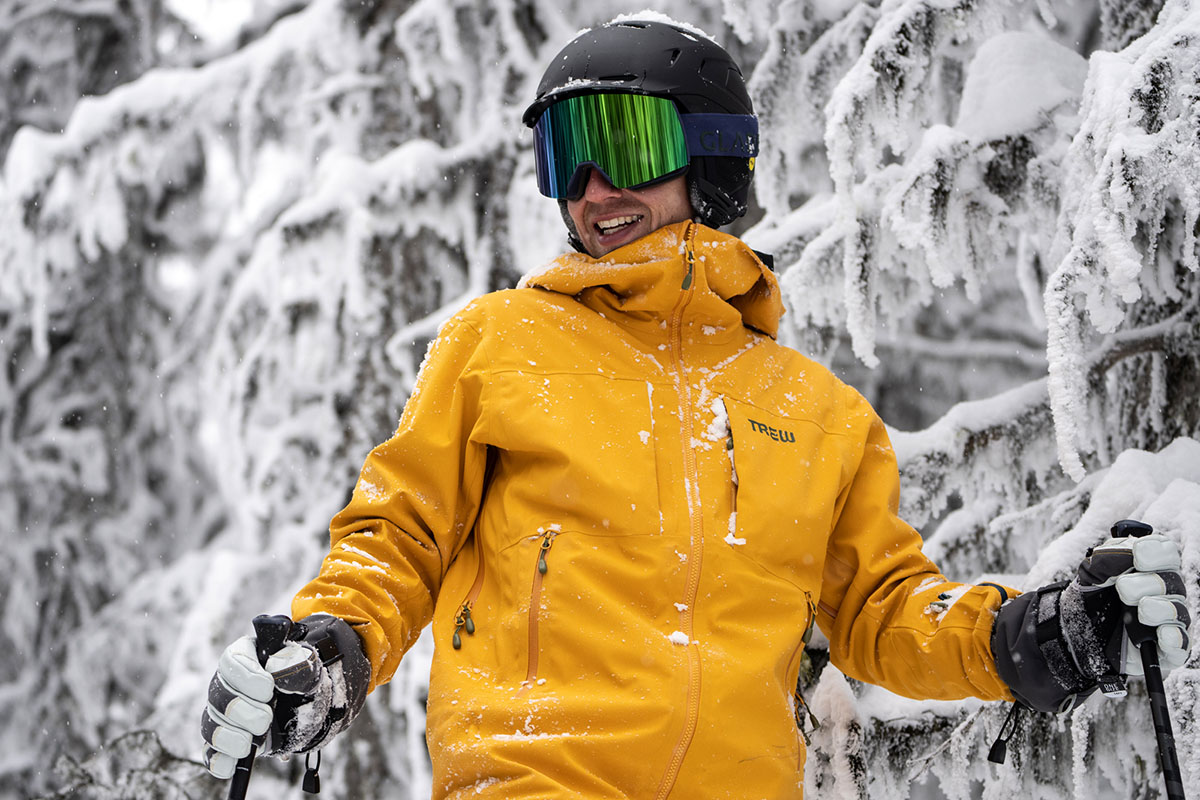
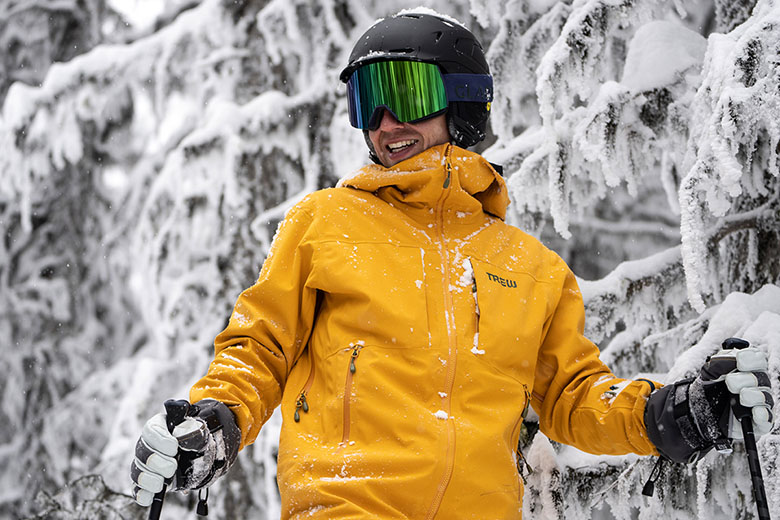
Switchback Travel (Jason Hummel)
Choosing the right ski jacket is all about managing the conditions that you might encounter on the mountain. This depends on the specific kinds of skiing you enjoy most—bracing against a Nor’easter on a lift in Maine is far different than skinning up a sunny ridgeline in the North Cascades in the PNW. Some people prefer a shell for its versatility, and some prefer a bit of insulation to keep the cold at bay. Budget-seekers like the all-in-one functionality of a 3-in-1 jacket, which comes with a separate insulating layer that can be zipped out of the shell. We’ve included all three in our picks for the best ski jackets of the 2024 season below. For further guidance, see our ski jacket comparison table and buying advice below the picks. We've also compiled a separate round-up of the best women's ski jackets, which exclusively covers women's-specific styles.
Editor’s note: We updated our ski jackets guide on April 23, 2024, to add the Arc’teryx Sabre SV and Rab Khroma Kinetic. We also included information about our testing practices and scanned the round-up to ensure all prices, colorways, and write-ups are up to date.
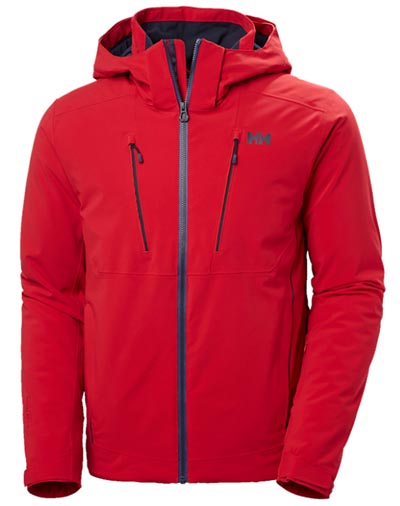 Best for: Resort
Best for: Resort
Type: Insulated (80 & 60g PrimaLoft Black)
Waterproofing: 2L Helly Tech Professional
What we like: Premium, insulated build; fantastic fit and feel from the stretchy fabric.
What we don't: Runs warm for active use.
Helly Hansen's Alpha 4.0 has all the features we look for in a capable resort-ready design. First, you get a moderate level of PrimaLoft Black Eco insulation in the body and sleeves for a nice boost in warmth compared with a non-insulated hardshell. It’s enough to take the sting out of a chilly ride up the chairlift but won’t overwhelm you on the way down. Second, the jacket offers fantastic comfort and mobility with a four-way stretch fabric—a noticeable upgrade from the mechanical stretch found in many alternatives—plush interior, and no-nonsense athletic fit. Finally, we love the styling of the Alpha 4.0, which is super clean, works well for riders of all ages, and is offered in a nice variety of colorways.
Helly Hansen updated the design for 2024 with a focus on sustainability. There's now recycled polyester along the shell and inner lining, and they incorporated OceanBound recycled material, which turns used fishing gear into synthetic yarns. Importantly, there are no performance drawbacks to the changes, and the rest of the winning design remains largely unchanged—including the handy insulated phone pocket, tall collar, and quality zippers. For downsides, breathability lags behind uninsulated shells as a result of the 2-layer build and emphasis on warmth (the pit zips and venting along the back of the lining do help). And if we’re nitpicking, the hood doesn’t provide as much coverage or fit as snugly as the Sabre SV below. But for a well-built, protective, supremely comfortable, and competitively priced insulated jacket, the Helly Hansen Alpha 4.0 is a resort standout. We also like the stretchier and slightly warmer Alpha LifaLoft Jacket, although it costs $75 more and has fewer features... Read in-depth Alpha 4.0 review
See the Men's Helly Hansen Alpha 4.0 See the Women's Helly Hansen Alphelia
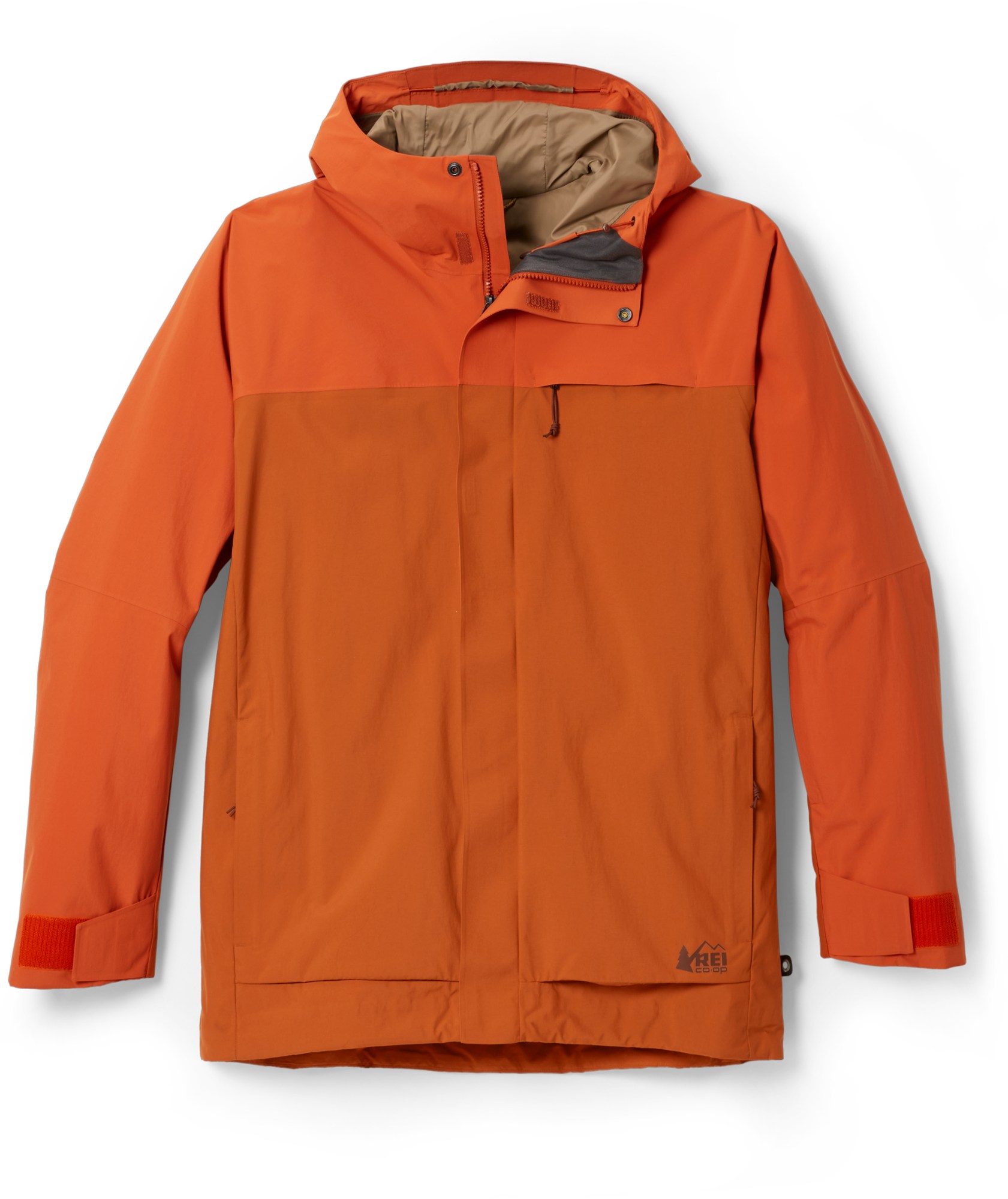 Best for: Resort
Best for: Resort
Type: Insulated (80 & 60g polyester)
Waterproofing: 2L Peak
What we like: A great value for a warm resort design.
What we don’t: Step down in material quality; only critically seam sealed.
Ski jackets can get very expensive—the Arc’teryx Sabre SV and Alpha SV below are the most expensive on the list at $900, for reference—but that doesn’t mean you need to spend big to get a quality product. For resort skiers looking for a warm and well-built jacket, the REI Co-op Powderbound is a nice choice. For just under $200, you get a waterproof build with 80-gram synthetic insulation around the core (lighter 60g is used in the sleeves), great organization both outside and inside the shell, and useful features like a powder skirt and pit zips. We even like the simple design and minimalist branding, which means that the Powderbound can be worn both for skiing and everyday winter use.
What are the shortcomings of REI’s entry-level ski jacket? The fit lands on the large end of the spectrum, and the more budget-oriented construction gives it a fairly bulky feel (especially when compared with a sleek insulated option like the Helly Hansen Alpha 4.0 above). And as with any jacket at this price point, REI’s proprietary waterproofing tech isn’t up to Gore-Tex standards—the shell is only critically seam sealed—nor should you expect Patagonia or Arc’teryx build quality or comfort. That said, we can’t help but love the value here: The Powderbound is everything most people need in a resort jacket and nothing they don’t.
See the Men's REI Co-op Powderbound See the Women's REI Co-op Powderbound
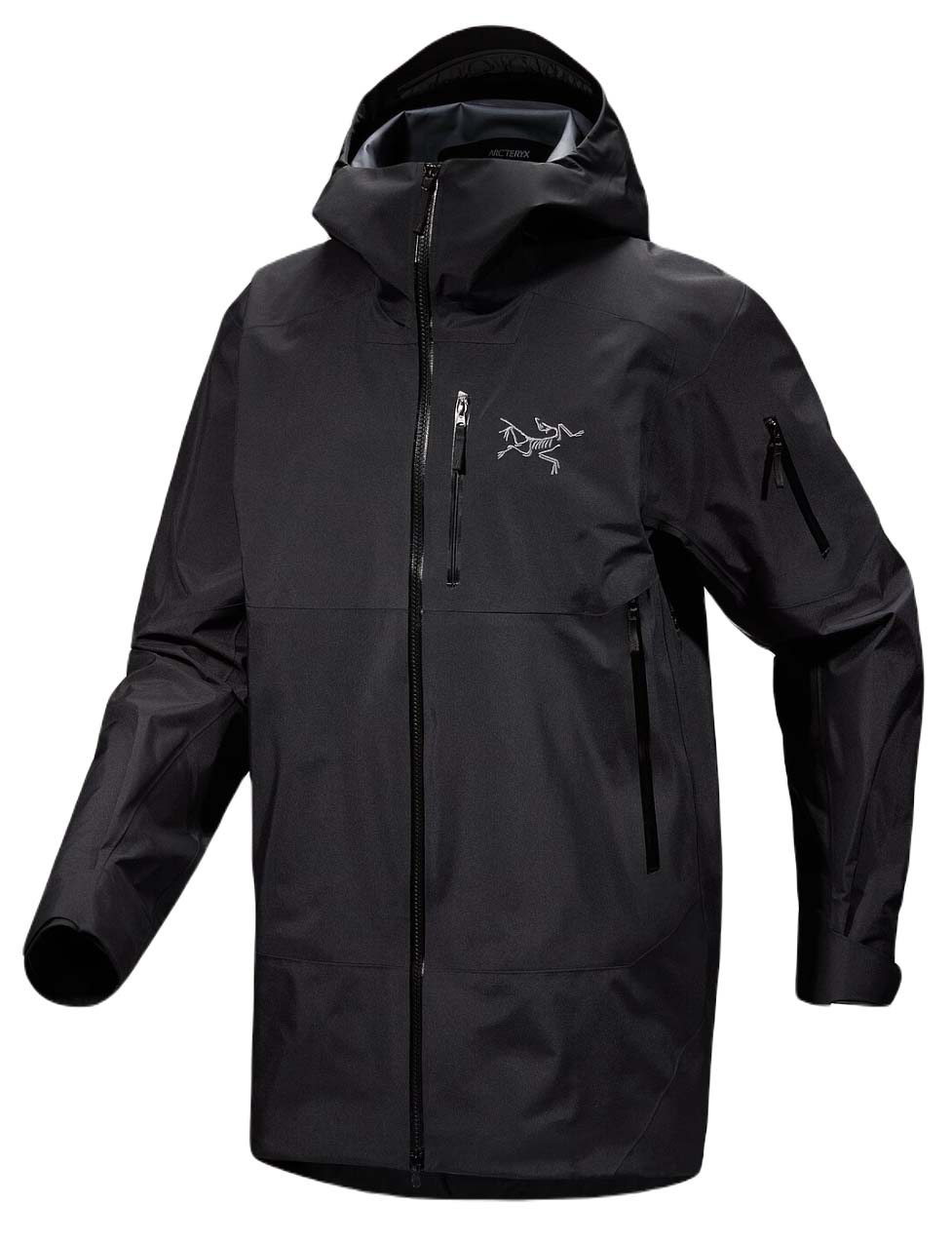 Best for: Backcountry/resort
Best for: Backcountry/resort
Type: Shell
Waterproofing: 3L Gore-Tex Pro
What we like: Top-notch protection and versatile for both resort and backcountry use.
What we don’t: The priciest option on our list by a sizable margin; fit runs big.
Arc’teryx dominates the high-end jacket market, and their men’s Sabre and women’s Sentinel collections are fan favorites among resort and backcountry skiers alike. The men's-specific Sabre SV (short for "severe weather") sits at the top of the lineup and offers best-in-class waterproofing and durability for frequent and rough use. For backcountry-goers, it's reasonably light at 1 pound 5 ounces and boasts ample pockets (both zippered and drop-in stash) for divvying up the essentials. For days spent inbounds, Arc'teryx didn't skimp on resort-friendly additions like an integrated powder skirt, committed pass pocket, and a thick (100D) exterior that will stand up well to long-term use. Tack on Gore's top-end Pro membrane, and the net result is a bombproof, durable, and highly capable shell that handily pulls double duty.
Though the Sabre SV might seem like a jack of all trades, it does fall short in a few areas. For backcountry use, it's not the lightest option available due to the aforementioned resort-oriented features and ultra-thick shell fabric. Further, while the "regular" fit is great for layering underneath, some may find it a little big and bulky. Finally, the Sabre SV is tied for the most expensive option here (along with Arc'teryx's own Alpha SV below) at a whopping $900, which will be out of reach for many. It's worth noting that we previously had the standard Sabre Jacket listed here, which was a few ounces heavier but included a soft-touch liner for a small dose of warmth (great for cold chairlift rides) and retailed for a more palatable (but still pricey) $750. The Sabre is largely out of stock at the time of publishing, however, and the SV is the more weather-ready and durable of the two.
See the Men's Arc'teryx Sabre SV
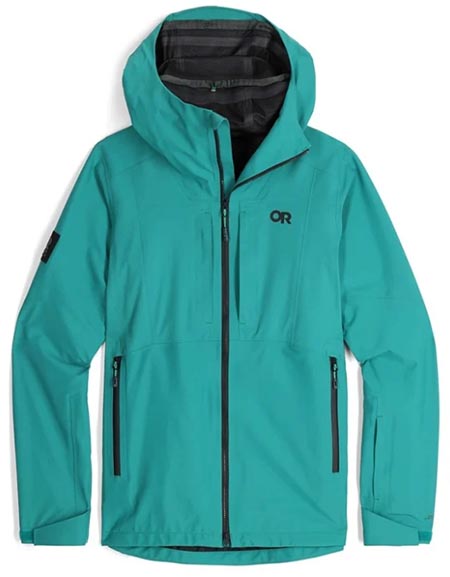 Best for: Backcountry
Best for: Backcountry
Type: Shell
Waterproofing: 3L AscentShell
What we like: Excellent value for a fully featured, comfortable, and breathable touring shell.
What we don’t: Not a standout in truly wet conditions; a couple fit and finish complaints.
In-house fabric technologies often fall short, but Outdoor Research’s AscentShell is an exception. The impressive 3-layer design stretches like a softshell, is extremely breathable, and is fully waterproof. The latest ski jacket to utilize the electro-spun tech is the backcountry-focused Skytour. Replacing the popular Skyward, the shell was quick to win us over: The Skytour's lighter materials cut weight and improve breathability, and they swapped the somewhat polarizing full-length side vents for standard pit zips. Importantly, organization remains excellent—it’s fully backcountry-ready with six total pockets—and the interior is soft, moisture-wicking, and very flexible. Added up, you simply won’t find a better-tuned jacket for staying cool and comfortable on the mountain.
What are you sacrificing at the Skytour’s $399 price point? Build quality is a step down from the ridiculously high attention to detail that you get from the Arc’teryx Sabre SV above, and the OR jacket has a couple small annoyances like a single adjustment at the hem that pulls the jacket to the side when cinched tight. In addition, the AscentShell fabric doesn’t have the batten-down-the-hatches feel of the Gore-Tex options, and the latest, trimmed-down variation won’t be a standout in particularly wet and heavy snow. That said, the Skytour’s breathability, fantastic comfort, and complete feature set at a very reasonable price make it our top 2024 touring pick.
See the Men's Outdoor Research Skytour See the Women's Outdoor Research Skytour
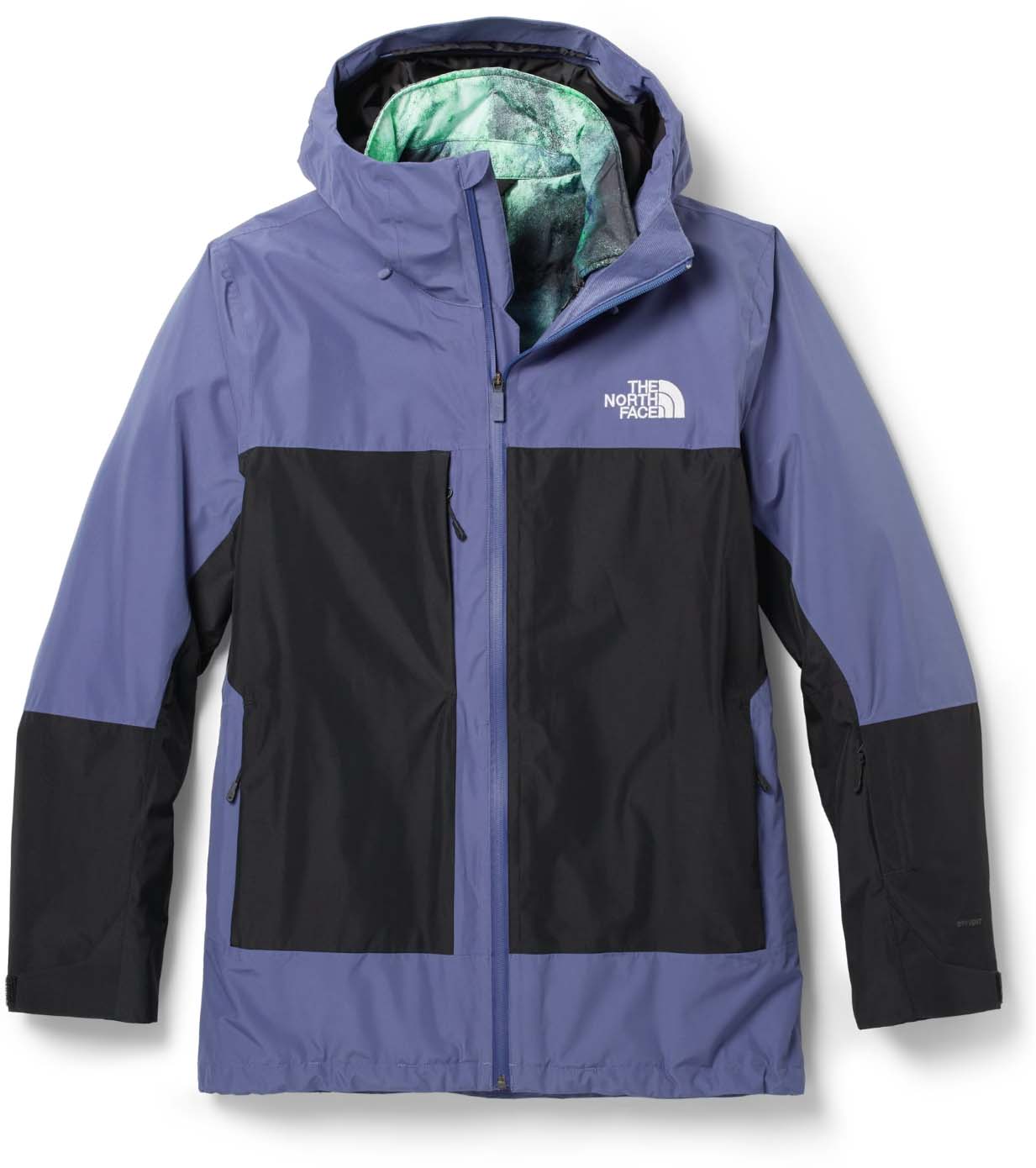 Best for: Resort
Best for: Resort
Type: 3-in-1 (11 g/sqft ThermoBall)
Waterproofing: 2L DryVent
What we like: 3-in-1 versatility and quality ThermoBall insulation.
What we don’t: Extra zippers add weight and bulk.
For those looking to save, turning to a 3-in-1 ski jacket can be a good option. With a single purchase, you get both a waterproof shell and an insulating midlayer that can be either zipped in on cold days or left at home in spring conditions (you can even wear the insulated jacket on its own around town). Many 3-in-1s are of the budget variety, but we think upgrading to the $400 The North Face ThermoBall Eco Snow is worth the investment. The jacket has a nice fit, offers decent exterior storage, and includes upgrades like pit zips and exposed, water-resistant zippers. Its standout feature, however, is the ThermoBall zip-out jacket, which we've found does a pretty good impression of a lofty down piece—all while continuing to insulate when wet.
If you’re set on the 3-in-1 design, the ThermoBall Snow Triclimate is our favorite option on the market, but we typically prefer the versatility of separating our jackets and midlayers. The extra zippers and heft that come with this kind of outer layer make them not as comfortable and they provide less freedom of movement. Further, 3-in-1s are more prone to feeling drafty, plus the connected midlayer limits access to your interior pockets. That said, the ThermoBall Snow Triclimate provides two well-built jackets with relatively few compromises, making it a solid buy for resort skiers.
See the Men's TNF ThermoBall Triclimate See the Women's TNF ThermoBall Triclimate
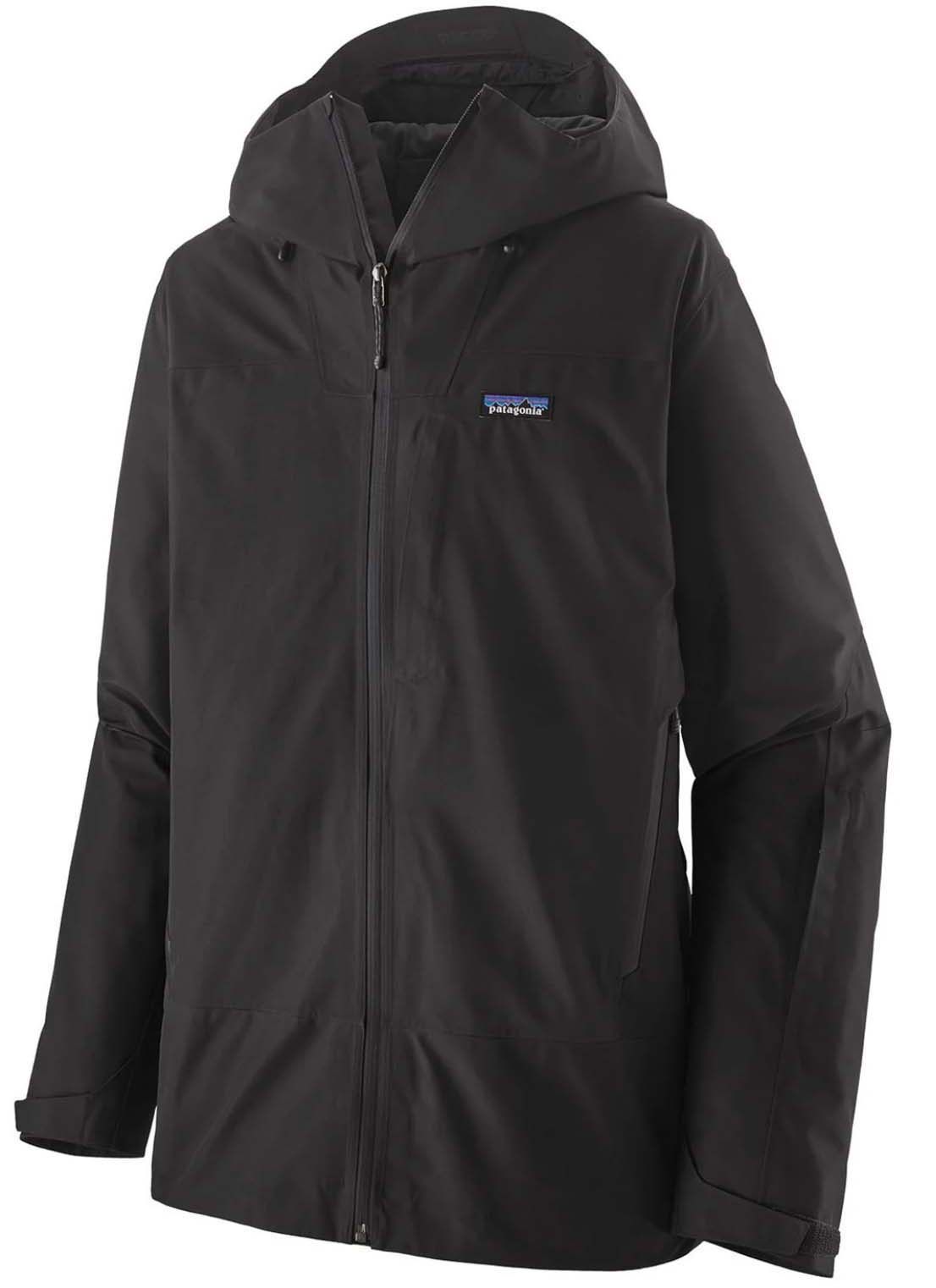 Best for: Resort
Best for: Resort
Type: Shell (fleece liner)
Waterproofing: 2L Gore-Tex
What we like: Durable materials, soft interior lining, and impressive sustainability measures.
What we don’t: Expensive for a 2-layer design.
Patagonia’s Powder Town below is their core design for resort skiers, but the Storm Shift offers a step up in just about every department. You get solid waterproofing by way of a premium Gore-Tex membrane (it’s kept us bone dry in wet PNW conditions), along with a 150-denier shell that holds up to all manner of resort abuse. We’ve found the Storm Shift to be surprisingly supple and mobile despite the thick fabric, and the cozy interior lining (a mix of a zigzag patterned fleece and soft taffeta material) is a really nice touch that makes the jacket fun to wear and adds a bit of breathable warmth, too. Tack on a full suite of features (including fleece-lined hand pockets, a large interior dump pocket, snow skirt, pit zips, and more), and the Storm Shift has quickly become one of our favorite all-mountain jackets for resort use.
Patagonia is known for their sustainable materials and design, and the Storm Shift is the epitome of this ethos. The Gore-Tex construction is completely PFC-free—including the membrane, DWR, and fabric—and recycled materials are used throughout, plus the jacket is Fair Trade Certified sewn. We’ve found that the DWR soaks through faster than most non-PFC-free treatments (thankfully, the Gore-Tex puts up a strong defense), and at almost $500, we’d expect the Storm Shift to have water-resistant zippers rather than fabric flaps over the pass pocket, chest pocket, and pit zips. Finally, it’s a shame that the internal and external chest pockets are on the same side, which causes excess bulk if you’re storing items in both at once. But in the end, these are relatively minor nitpicks about a jacket that we love; if you’re willing to pay the price, the Storm Shift is one of the most well-rounded resort shells here... Read in-depth review
See the Men's Patagonia Storm Shift See the Women's Patagonia Storm Shift
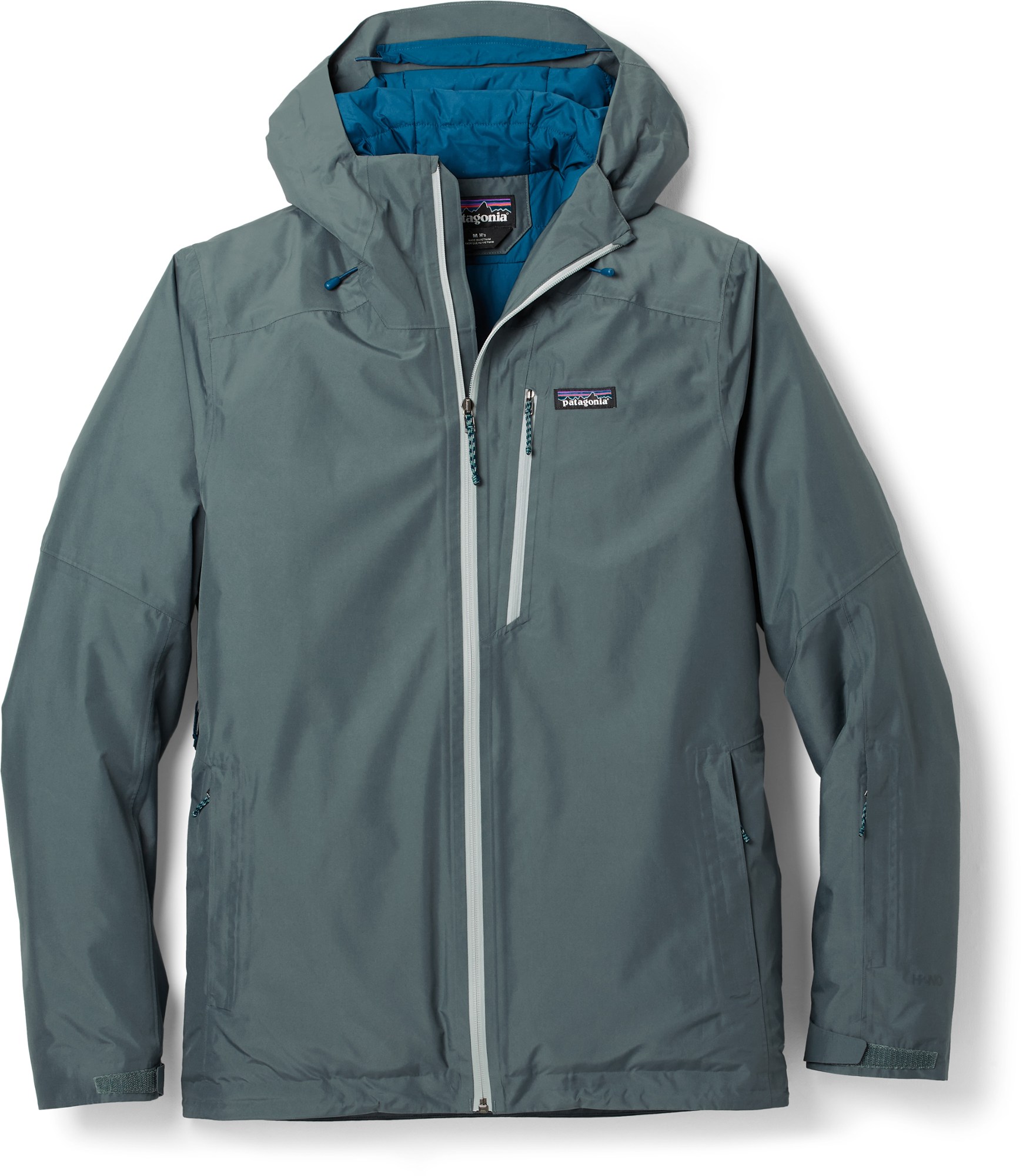 Best for: Resort
Best for: Resort
Type: Insulated (80g & 40g Thermogreen)
Waterproofing: 2L H2No
What we like: A warm and comfortable resort jacket.
What we don’t: Less of a performance piece than the Alpha 4.0 above.
Patagonia doesn’t really dabble in the entry-level end of the market, but the brand’s Powder Town has a lot of appeal for resort-goers. Offered in a range of styles—including an uninsulated shell and 3-in-1 jacket—we like the insulated model best: It’s quite warm with 80-gram synthetic in the body, and includes thoughtful touches like a drop-in interior pocket for goggles and a soft-touch taffeta lining. We’ve also been impressed by Patagonia’s in-house H2No waterproofing, and the adjustable hood and powder skirt do a nice job sealing out the cold and wet. For days lapping the resort, the Insulated Powder Town is a cozy and well-built option.
The Powder Town replaced the popular Snowshot/Snowbelle in Patagonia’s lineup for last season. Changes to the design include a revamped pocket layout, new colorways, and—importantly—more sustainably sourced materials, including a postconsumer recycled polyester shell, 100% recycled insulation, and PFC-free DWR. However, like its predecessors, the Powder Town isn’t ideal for active use or mild conditions: The 2-layer design is lacking in breathability compared to more premium 3-layer competitors, and the warm construction means you’ll quickly work up a sweat on sidecountry trudges, riding in the trees, or when hitting the park. For an upgraded resort option from Patagonia, check out the Storm Shift above... Read in-depth Powder Town review
See the Men's Patagonia Powder Town See the Women's Patagonia Powder Town
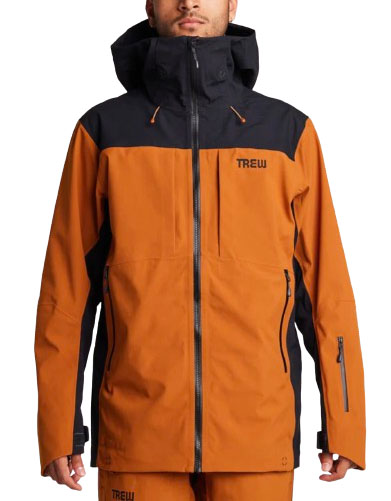 Best for: Resort/backcountry
Best for: Resort/backcountry
Type: Shell
Waterproofing: 3L PNW Primo
What we like: Tough and protective yet very comfortable; feature-rich with lots of storage.
What we don’t: Heavier and less streamlined for touring than the OR Skytour above.
For those who haven’t been introduced, Trew Gear is an Oregon-based company that excels in the mid-range and high end of the resort and backcountry markets. Their designs are super well made and have clean styling, and durability and weatherproofing are performance hallmarks. One of their latest creations is the Cosmic Jacket Primo, which targets the crossover resort and touring space with a tough 3-layer construction, pockets galore (five on the exterior, two mesh dump pockets inside, and a new-for-2024 zippered interior pocket), and excellent coverage from the long cut. We think the construction splits the difference nicely between the hardshell and softshell categories, mixing great all-around protection with some built-in stretch and a smooth interior for added comfort.
We put nearly a full season in with the Cosmic Jacket Primo and found it to be an awesome resort and sidecountry piece: There’s good mobility thanks to the woven shell, the thick exterior performed flawlessly in a range of harsh and wet conditions, and all the touch points have a quality and well-built look and feel. The feature-rich build does come with some compromises in breathability and comfort for dedicated ski touring, and we think a lighter, thinner, more packable, and more streamlined option like the OR Skytour above will be the better option for most. But as a 90/10 resort and backcountry piece, it’s a compelling design. In terms of fit, the Cosmic has a “relaxed style,” and we wound up sizing down—and being very happy with the athletic cut... Read in-depth review
See the Men's Trew Gear Cosmic Primo See the Women's Trew Gear Stella Primo
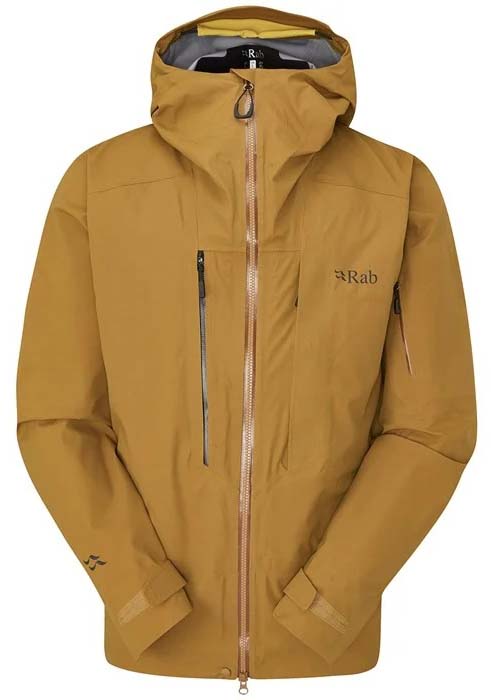 Best for: Backcountry
Best for: Backcountry
Type: Shell
Waterproofing: 3L Proflex
What we like: A high-quality backcountry shell that competes closely with the OR Skytour above.
What we don't: We prefer standard pit zips for dumping excess heat; no hand pockets and thin shell fabric.
From across the pond, Rab is a technical brand designing high-quality ski shells with competitive price tags to match. Our current favorite in their lineup is the Khroma Kinetic Waterproof Jacket, which competes closely with the OR Skytour above as a stretchy and breathable—but still fully waterproof—backcountry design. Highlights include a 3-layer Proflex membrane that's reliably weather-ready, a healthy amount of elastane (10%) for excellent mobility, a competitive weight of just 1 pound 2.9 ounces (3.2 oz. lighter than the Skytour), and a touring-friendly feature set that includes massive Napolean-style chest pockets, a helmet-compatible hood, and trusty YKK AquaGuard zippers. While not the cheapest option here, the Rab's $400 price tag strikes us as entirely reasonable given the jacket's technical intentions, high-quality build, and clear attention to detail.
Despite our love for the Khroma Kinetic, it falls a little short of the OR Skytour above and other backcountry designs here. Most notably, the Rab forgoes traditional underarm vents in favor of vents at the back of the sleeves, along with mesh inside the chest pockets. While serviceable for mild days and short tours, traditional pit zips are far more effective at dumping excess heat. The Khroma Kinetic also omits hand pockets and uses a notably thin 20-denier shell (for reference, the Skytour's is 40D x 65D) to keep weight low, which isn't uncommon among backcountry-ready designs but does detract from overall versatility. To be sure, the Rab is a solid value at $400 and a very thoughtfully built option for those who like to earn their turns, but the Skytour strikes us as the slightly more competitive design for the price.
See the Men's Rab Khroma Kinetic See the Women's Rab Khroma Kinetic
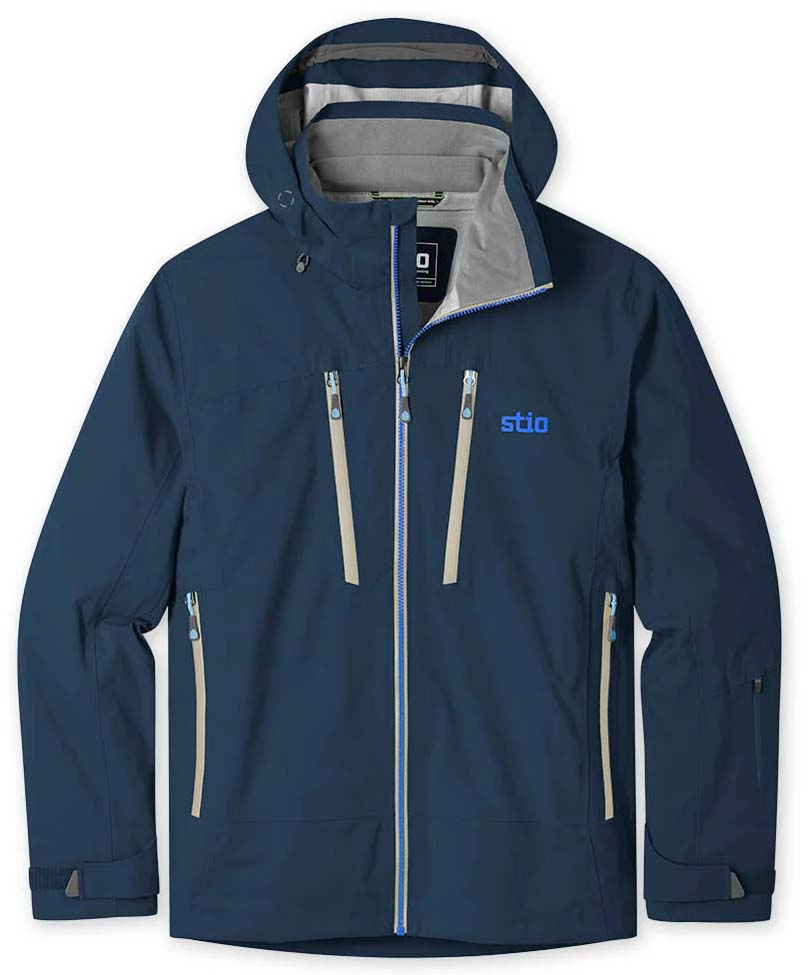 Best for: Resort
Best for: Resort
Type: Shell
Waterproofing: 3L PeakProof
What we like: Tons of storage, strong performer in rough weather, and built to last.
What we don’t: Feels pretty heavy for an uninsulated shell; removable hood isn’t as protective as non-removable alternatives.
Like Trew Gear, Stio is a brand on the rise, and especially in the ski outerwear game. We’ve been putting a lot of their gear to the test this winter, and the Environ Jacket has stood out as a premium shell that excels for resort and sidecountry riding. The 3-layer build has a substantial feel that’s held up great in some pretty miserable conditions—including a couple all-day rain sufferfests—and there’s tons of organization both along the exterior and interior (we particularly like the big zippered interior pocket that’s phone-friendly). Stio also aced the details with smooth-operating zippers, glove-friendly zipper pulls, and a nice, tall collar that’s fleece-lined for comfort. For a competitive $465, the Environ adds up to a very compelling resort option.
When I first donned the Stio Environ, it immediately reminded me of the Trew Gear Cosmic Primo (above) that I tested last season. The burly construction has a real heft to it—this isn’t a jacket we’d take deep in the backcountry—but there’s no questioning its protection or toughness. One difference between the two is that the Stio’s hood can be removed, which is a positive for those who don’t like their hood flapping away on mild-weather days. The trade-off is that the removable design isn’t as protective along the sides of the face and takes more fiddling to secure over a helmet. But outside of the weight and hood complaints, the Environ has passed all other tests with flying colors. We also like their lighter and more streamlined Environ XT, as well as the more freeride-inspired Figment Jacket.
See the Men's Stio Environ See the Women's Stio Environ
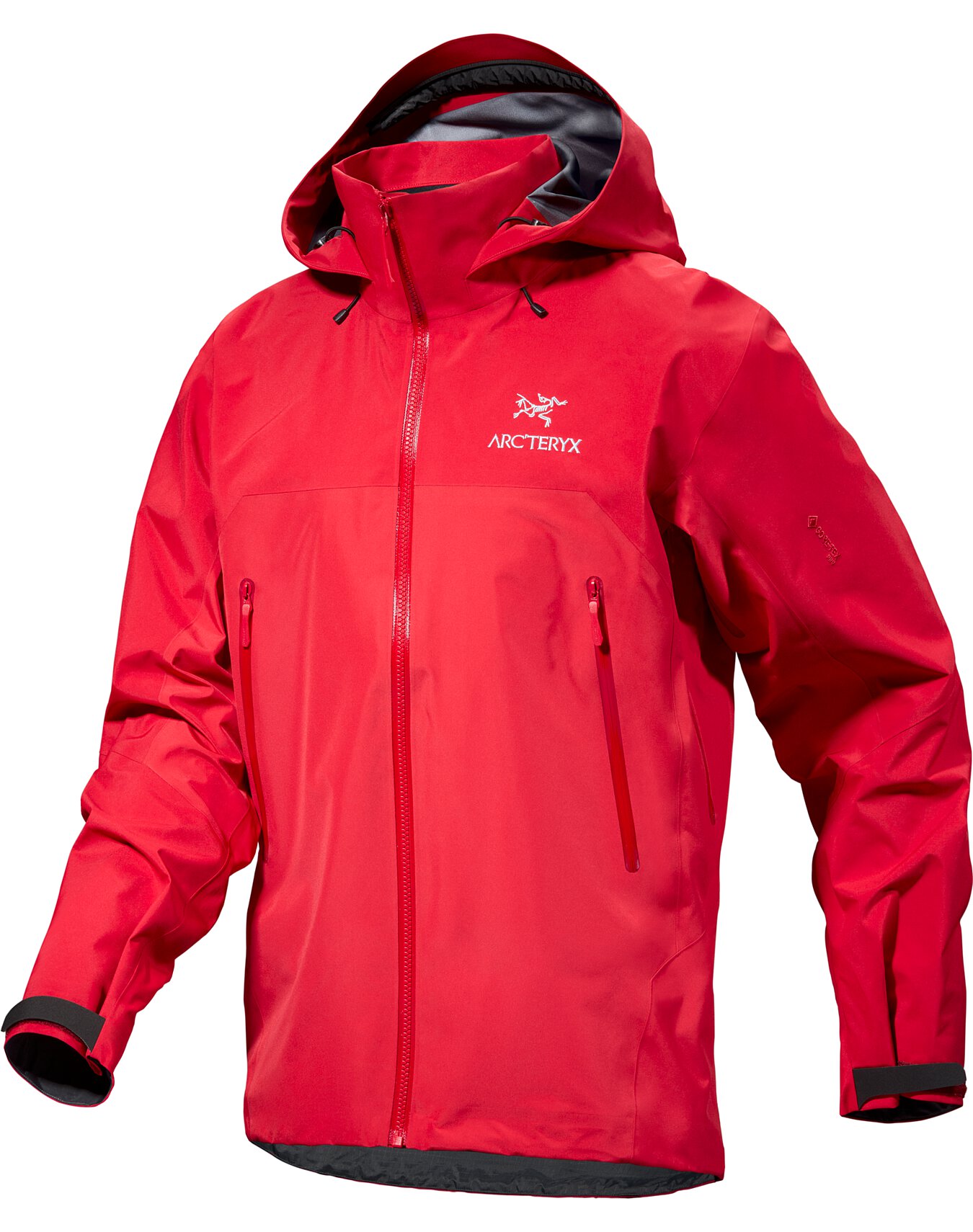 Best for: Backcountry
Best for: Backcountry
Type: Shell
Waterproofing: 3L Gore-Tex Pro
What we like: An incredibly weatherproof, durable, and versatile hardshell.
What we don't: Not a ski-specific piece; a little lacking in breathability.
If you’re an Arc’teryx enthusiast, it’s likely you’re already familiar with the iconic Beta AR Jacket. Slotting in as the brand’s all-rounder, the Beta AR isn’t ski-specific but checks many of the boxes we look for in a quality winter and alpine hardshell, earning it a spot on our list this season. Like the $300-pricier Sabre SV above, the Beta AR boasts Gore’s top-of-the-line Pro membrane that provides trustworthy protection even in rough and rowdy conditions. We also appreciate that Arc’teryx equipped wear-prone areas like the shoulders and hood with beefy 80-denier reinforcements (the rest of the jacket is 40D). And at just over a pound, the Beta AR is light enough to go largely unnoticed on the skin track while retaining key features like a helmet-compatible hood, large pockets, and a versatile “regular” fit that can accommodate layers underneath but doesn’t feel overly bulky.
All that said, the Beta AR is a little lacking as a ski-specific piece. Though we love the proven Gore-Tex Pro membrane for protection, it falls short in breathability for backcountry use—especially compared to designs like the OR Skytour and Rab Khroma Kinetic above. The large pit zips certainly help, but we found the Beta AR best suited for cold weather, during transitions, or on descents (e.g., times when we're not likely to work up a sweat). Additionally, the jacket's 30.3-inch back length is a little short for skiing or wearing consistently under a harness, and the lack of drop-in pockets means there's no good spot to stash items like skins, goggles, or gloves. All that said, if you're looking for a multi-use shell to wear on a variety of adventures—from skiing to alpine climbing to hiking and backpacking in rough weather—the Beta AR is an impressively versatile design that will hold up well over the long term… Read in-depth review
See the Men's Arc'teryx Beta AR See the Women's Arc'teryx Beta AR
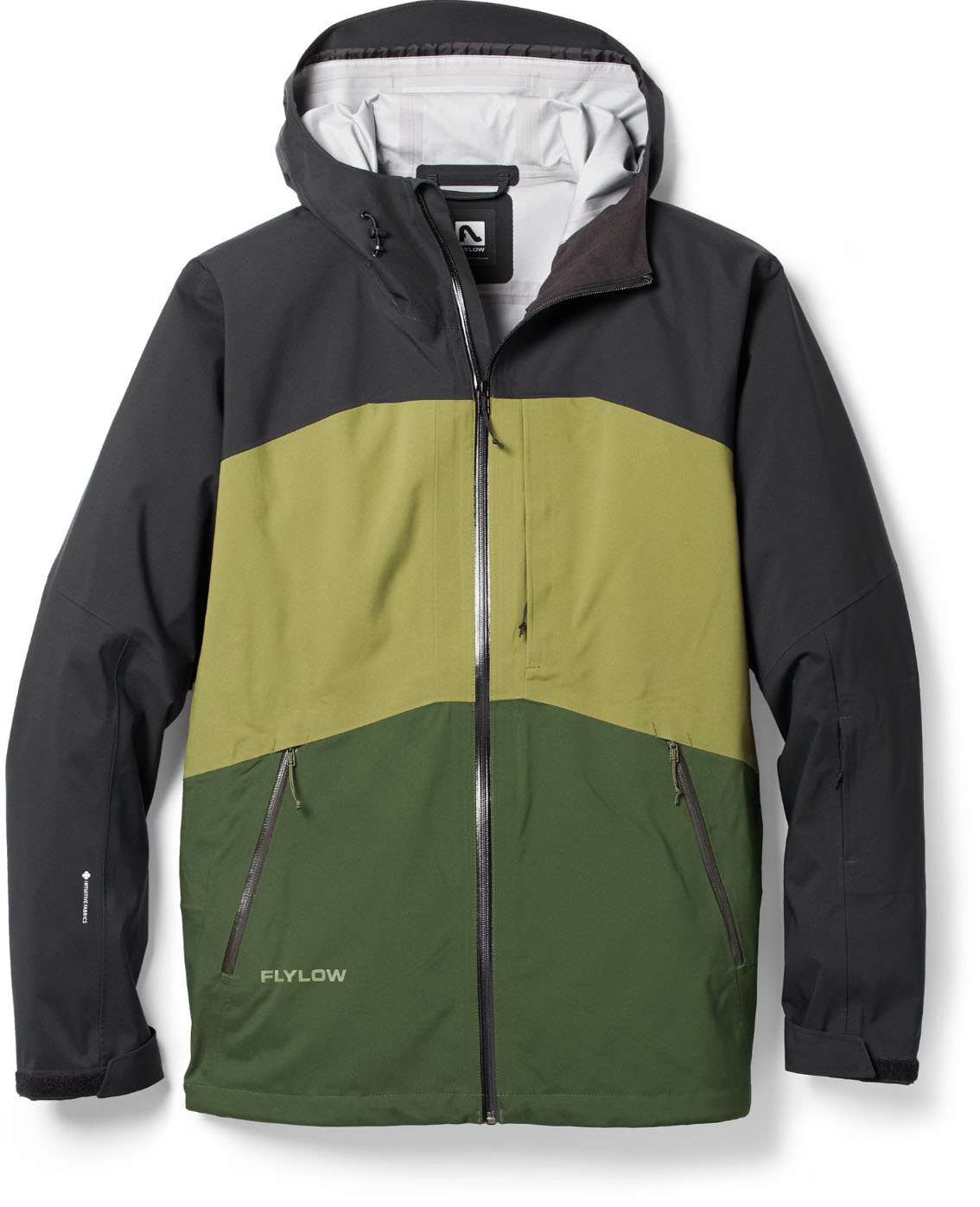 Best for: Backcountry/resort
Best for: Backcountry/resort
Type: Shell
Waterproofing: 3L Tactic
What we like: Softshell-like comfort and stretch in a protective, 3-layer design.
What we don’t: Lacks the bombproof feel of Gore-Tex-equipped hardshells.
The Flylow men’s Malone and women’s Lucy jackets combine the best attributes of softshell and hardshell designs into a well-rounded package. For sidecountry hikes or quick backcountry tours, the stretchy construction and smooth interior offer standout comfort. If a storm rolls in, the 3-layer waterproof build does a good job blocking wind and snow, and the extended collar covers all but your nose when zipped up. We also think Flylow nailed the styling of both the Malone and Lucy—particularly in the tri-color patterns—and all of the materials impressed us from a quality standpoint.
Unsurprisingly, the emphasis on comfort and stretch does impact the Flylow’s bombproof feel. Its DWR coating sheds snow effectively, but it’s not as well equipped for particularly wet and nasty days (those in the Pacific Northwest who get out a lot likely will want more protection). We also were a little disappointed by the organization: The jacket lacks an internal dump pocket for storing goggles or climbing skins, and the chest pockets were too small to fit a large phone (in our case, an iPhone 11). Nitpicks aside, the clean-looking Flylow jacket hits a really nice middle ground of comfort and performance for mixed resort and backcountry use... Read in-depth review
See the Men's Flylow Gear Malone See the Women's Flylow Gear Lucy
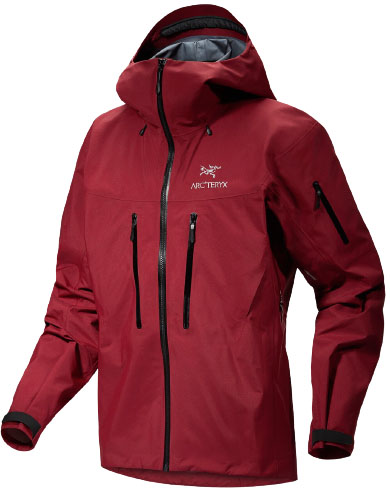 Best for: Backcountry
Best for: Backcountry
Type: Shell
Waterproofing: 3L Gore-Tex Pro
What we like: Versatile and bomber alpine shell with proven performance.
What we don’t: Huge price tag and decidedly more alpine- than ski-focused.
Like Arc'teryx's own Beta AR above, their higher-end Alpha SV hardshell isn’t designed exclusively for skiing, but it’s a very legitimate option nonetheless. It has everything we love and expect from an Arc’teryx jacket: It fits great, is bombproof with Gore's latest Pro membrane and 100-denier face fabric (the Beta AR uses thinner 40 and 80D materials), and is one of the lightest models on this list at just over 1 pound (there’s a reason we’ve ranked it highly in our hardshell round-up for years). This do-everything jacket is fantastic for backcountry use but isn’t out of place on a resort day with its strong weather protection and layering-friendly, long cut.
What do you give up with the non-ski-specific Alpha SV? As we saw with the Beta AR above, you don't get a powder skirt for deep snow days, and the more alpine-focused Alpha takes it a step further by omitting hand pockets (great for layering under a harness but not so much for around-town use). If these are important to you, check out the ski-specific Sabre SV above. This premium shell also performs extremely well in brutal conditions with a 100-denier Gore-Tex Pro build but tacks on useful additions like hand pockets, a powder skirt that connects to compatible Arc’teryx snow pants, and a slightly longer cut (by about half an inch). Both are undeniably premium pieces with steep ($900) price tags to match, but all-around performance and build quality are top-notch... Read in-depth Alpha SV review
See the Men's Arc'teryx Alpha SV See the Women's Arc'teryx Alpha SV
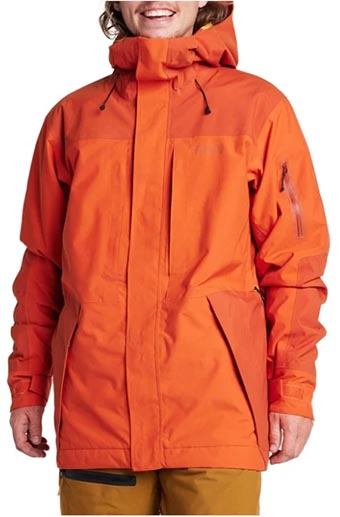 Best for: Resort
Best for: Resort
Type: Insulated (60g synthetic)
Waterproofing: 2L PNW
What we like: Extremely durable, great coverage and protection in wet conditions, and functional feature set.
What we don’t: Heavy and bulky-feeling.
The second Trew Gear shell to make our list, the men’s Tatoosh and women’s Trillium are the brand’s first foray into the popular insulated jacket category. They’re priced right at $349, offer a balanced level of warmth with 60-gram synthetic fill, have bomber face fabrics (the 200D x 320D nylon is the thickest here), and are cut long for maximum coverage. This recipe makes them a natural fit in classic Pacific Northwest conditions: wet, rowdy, and—at times—deep. And like the Cosmic Primo above, Trew incorporated quality materials throughout, including a YKK AquaGuard center zipper, pit zips, a removable powder skirt, and plenty of storage.
Many of Trew Gear’s jackets are available in multi-color layouts—similar to Flylow’s fun designs—although the Tatoosh and Trillium come in a couple classy solid colorways as well. Comfort is another strong suit with an impressively smooth lining and relaxed fit (as with the Cosmic, check the size chart and consider sizing down if you prefer a trim cut). One downside of the build is that it’s rather heavy and bulky-feeling for a jacket with relatively light insulation—a consequence of the 2-layer build and thick fabrics—so we wouldn’t recommend hauling it on any significant sidecountry adventures. But if you stay inside the ropes and want a well-sorted, long-lasting insulated shell, the Tatoosh and Trillium deserve your attention. For a similar design from Trew without insulation, check out their men’s Jefferson and women’s Astoria jackets.
See the Men's Trew Gear Tatoosh See the Women's Trew Gear Trillium
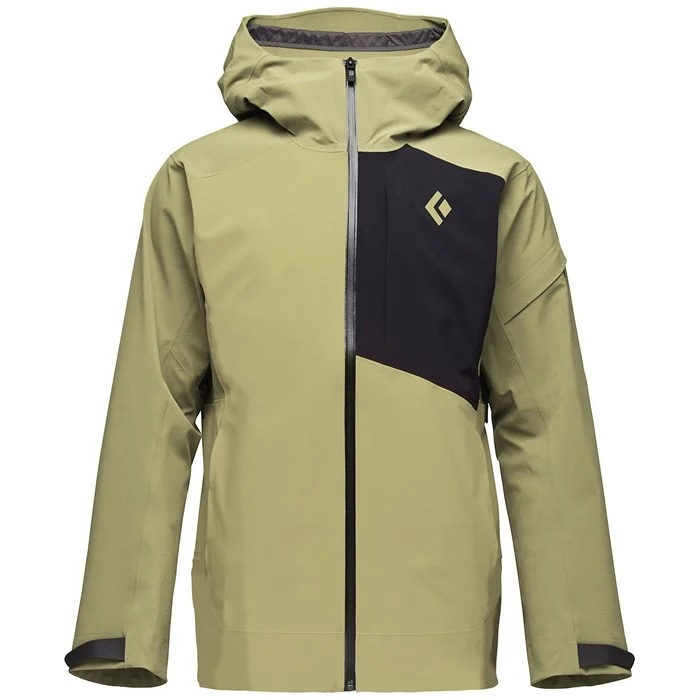 Best for: Resort/backcountry
Best for: Resort/backcountry
Type: Shell
Waterproofing: 3L BD.dry
What we like: Very stretchy and comfortable with good organization.
What we don’t: Feels heavier than a standard hardshell; single hem cinch pulls the jacket to the side.
In only a few years, Black Diamond has gone from the launch of its ski apparel line to being a serious player. Their current collection covers everything from backcountry-specific shells to insulated resort pieces, and the Recon is our current favorite of the bunch. An all-rounder that excels both inside and outside of the ropes, the jacket combines Black Diamond’s proprietary 3-layer BD.dry membrane with a four-way-stretch shell, translating to strong weather protection with little compromise in the way of comfort and mobility. Uphill enthusiasts will love the removable powder skirt and internal mesh drop pockets for storing their skins, while resort-goers will find the Recon ready to charge, with features like a lift pass pocket on the left arm and ski helmet-compatible hood.
Similar to the Outdoor Research Skytour above, the BD Recon Stretch is a non-insulated shell that stands out for being both waterproof and breathable. Both jackets feature stretchy face fabrics and proprietary 3-layer constructions, although we've found the BD to be heavier and bulkier-feeling, particularly when active (such as on a sidecountry hike). Second, Black Diamond’s build quality can be hit or miss, and the Recon in particular fit us long, which led to some awkward bunching around the hem. Finally, the single waist adjustment meant the jacket pulled surprisingly far to one side when cinched (we had a similar issue with the Skytour, although the OR doesn’t pull as dramatically to the side). But if those complaints aren’t dealbreakers, the Recon is undeniably a competitive ski shell with enough versatility for both the resort and backcountry.
See the Men's Black Diamond Recon Stretch See the Women's BD Recon Stretch
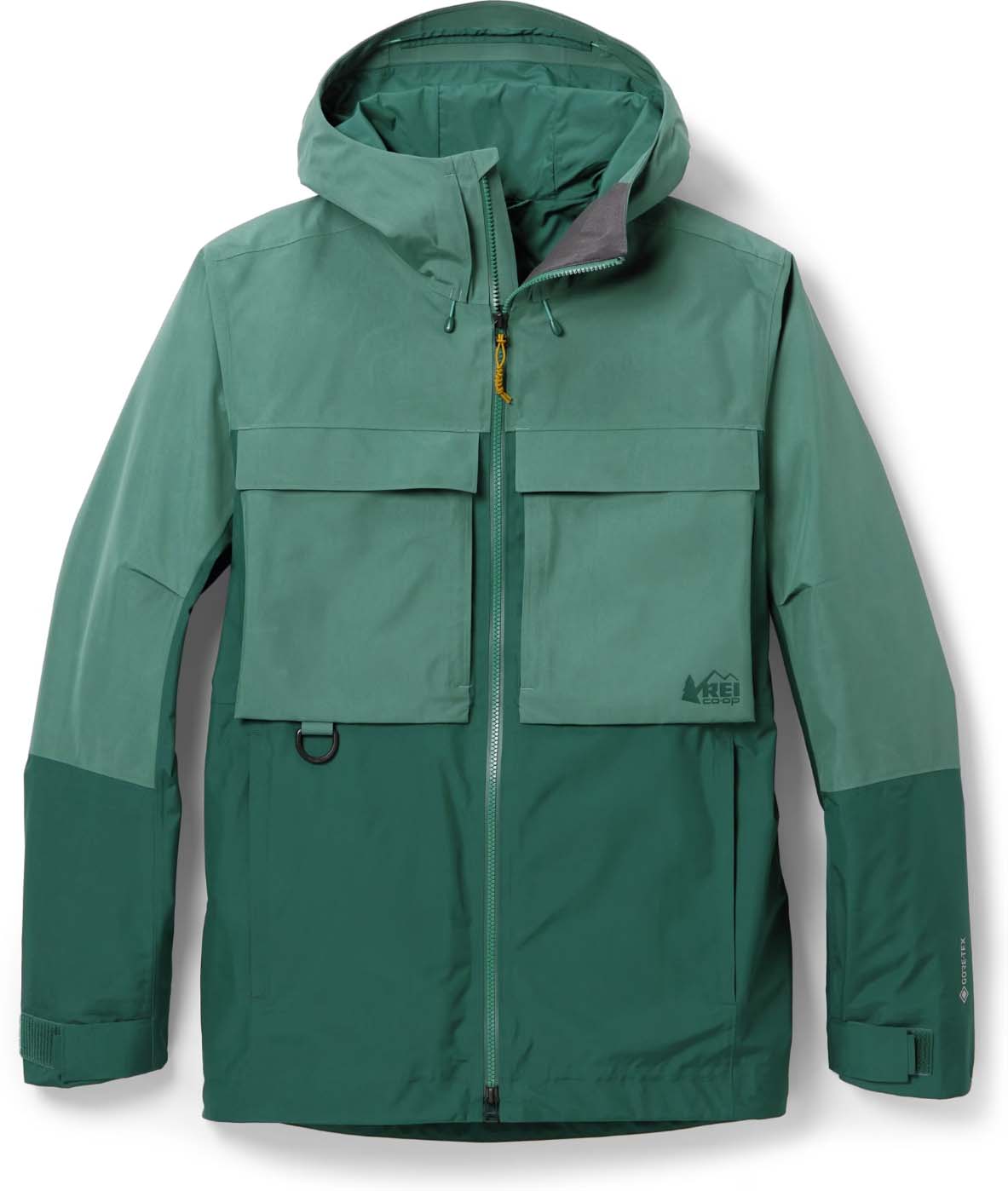 Best for: Resort
Best for: Resort
Type: Shell
Waterproofing: 2L Gore-Tex
What we like: Reliable Gore-Tex waterproofing at a good price; tall and extended sizes offered.
What we don’t: Trew Gear’s Jefferson costs the same and has a more comfortable and refined build.
REI jumped into the ski outerwear market a few seasons ago with a small collection of resort-focused pieces, and their current top-flight jacket is the First Chair GTX. As expected from the Seattle-based brand, this non-insulated shell is high on value: For $319, you get Gore-Tex waterproofing, a smooth interior, and valuable features like a powder skirt, pit zips, and seven well-distributed pockets. Another nice touch is the emphasis on sustainability, with a recycled polyester shell and lining, bluesign-approved materials, and Fair Trade certification. Available in a nice range of colors and sizes—including tall for men and up to 3X for women—the First Chair is a solid all-around option and particularly for resort riders.
As expected for the price, the First Chair isn’t as well suited for active use. Gore’s 2-layer construction isn’t a standout in terms of breathability, and the extra lining covering the interior adds both weight and bulk. In addition, they’ve incorporated cheaper fabric flaps over the zippers on the pockets and pit zips for waterproof protection (the center zipper is coated, however). Compared to the equally priced Trew Gear Jefferson (the uninsulated version of the Tatoosh above), the REI is lighter but has a more generic fit, lacks the quality feel on touch points like the zipper pulls and hood cinches, and isn’t as soft along the interior. But if you prioritize Gore-Tex waterproofing, storage, and value—an admittedly great combo—the First Chair is well worth checking out.
See the Men's REI First Chair GTX ePE See the Women's First Chair GTX ePE
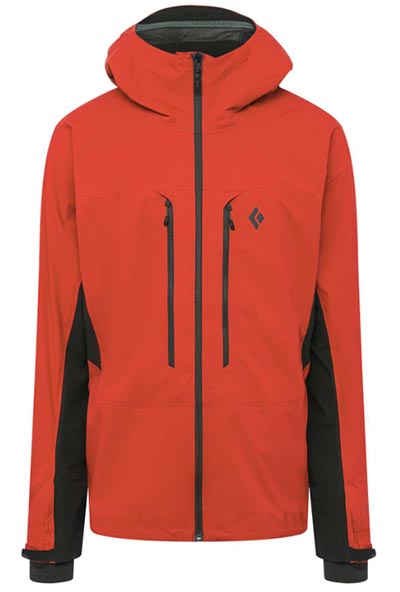 Best for: Backcountry
Best for: Backcountry
Type: Shell
Waterproofing: 3L BD.dry
What we like: Excellent breathability and stretchiness for mild-weather ski touring.
What we don't: Lack of full waterproofing dramatically reduces season-long versatility.
For ambitious tours in mild conditions, a softshell jacket is more breathable and has better stretchiness than a traditional hardshell. Black Diamond’s Dawn Patrol Hybrid stands out in this category thanks to its lightweight construction, trim and performance-oriented fit, and competitive price. The “Hybrid” in the name relates to its two fabric types: A windproof and waterproof 3-layer BD.dry shell covers the upper body, outer arms, and hood, while a thinner 2-layer softshell around the lower body and underarms lets out hot air and provides excellent mobility. This balanced design excels for springtime use and in areas like the Rocky Mountains that see a lot of dry snow throughout the season.
The most glaring downside to the Black Diamond’s hybrid build is that protection falls short in wet conditions and for resort days—even sitting on a chairlift can leave you vulnerable to moisture seeping through. As a result, the aptly named Dawn Patrol isn’t a one-jacket solution like the $34-pricier (and fully waterproof) Outdoor Research Skytour above. But if you value mobility and breathability on the uphill—the BD even incorporates a mesh panel along the inside of the center zipper to maximize airflow—the Dawn Patrol Hybrid makes a great secondary touring jacket.
See the Men's BD Dawn Patrol Hybrid See the Women's BD Dawn Patrol Hybrid
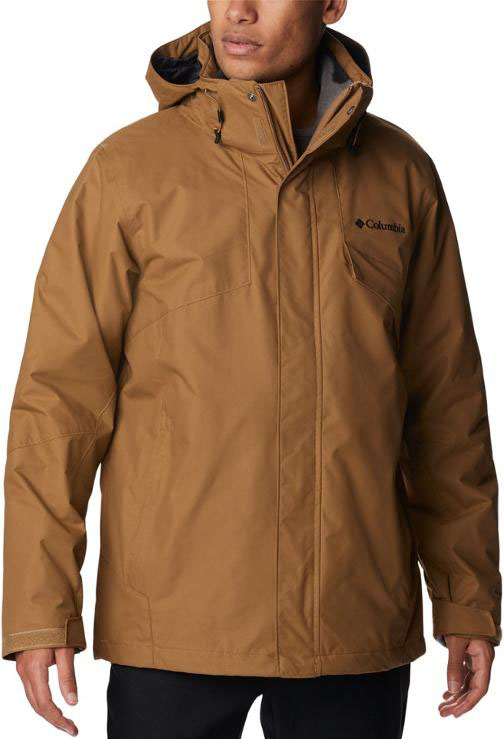 Best for: Resort
Best for: Resort
Type: 3-in-1 (fleece)
Waterproofing: 2L Omni-Tech
What we like: Affordable way to get out on the slopes.
What we don’t: Cheap construction and generic fit.
The essential duties of a resort jacket are to keep you warm, protected from moisture and wind, and have enough pockets for the basics. Columbia’s answer to these needs is the Bugaboo Interchange, a 3-in-1 ski jacket at a very attractive price point. It’s warm with a fleece zip-out jacket and Columbia’s signature (and somewhat polarizing) Omni-Heat reflective lining. The silvery interior is a little too disco for us when we slip it off, but it does feel like it’s working by radiating your body heat.
We’ve found the basic shell and lining do impact breathability, and a lack of pit zips means the Bugaboo can run hot. In addition, the material quality isn’t up to snuff compared with the options above and is more prone to wetting out (regular washing and reapplying the DWR does help). But on easy resort days coast to coast, this is all the jacket that most weekend warriors need. For a similar 3-in-1 design that trades the fleece liner of the Bugaboo for a synthetic jacket, check out the Columbia Whirlibird IV Interchange.
See the Men's Columbia Bugaboo See the Women's Columbia Bugaboo
| Jacket | Price | Best For | Type | Insulation | Waterproof | Weight |
|---|---|---|---|---|---|---|
| Helly Hansen Alpha 4.0 | $475 | Resort | Insulated | 80g / 60g | 2L Helly Tech | 2 lb. 8.6 oz. |
| REI Co-op Powderbound | $199 | Resort | Insulated | 80g / 60g | 2L Peak | 1 lb. 13 oz. |
| Arc'teryx Sabre SV | $900 | Backcountry/resort | Shell | None | 3L Gore-Tex Pro | 1 lb. 5 oz. |
| Outdoor Research Skytour | $399 | Backcountry | Shell | None | 3L AscentShell | 1 lb. 6.1 oz. |
| TNF ThermoBall Triclimate | $400 | Resort | 3-in-1 | 11 g / sqft | 2L DryVent | 2 lb. 8.8 oz. |
| Patagonia Storm Shift | $499 | Resort | Shell | None | 2L Gore-Tex | 1 lb. 12.8 oz. |
| Patagonia Powder Town | $399 | Resort | Insulated | 80g / 40g | 2L H2No | 1 lb. 15 oz. |
| Trew Gear Cosmic Primo | $499 | Resort/backcountry | Shell | None | 3L PNW Primo | 1 lb. 14.1 oz. |
| Rab Khroma Kinetic | $400 | Backcountry | Shell | None | 3L Proflex | 1 lb. 2.9 oz. |
| Stio Environ | $465 | Resort | Shell | None | 3L PeakProof | 1 lb. 13 oz. |
| Arc'teryx Beta AR | $600 | Backcountry | Shell | None | 3L Gore-Tex Pro | 1 lb. 0.3 oz. |
| Flylow Gear Malone | $400 | Backcountry/resort | Shell | None | 3L Tactic | 1 lb. 8 oz. |
| Arc'teryx Alpha SV | $900 | Backcountry | Shell | None | 3L Gore-Tex Pro | 1 lb. 1.1 oz. |
| Trew Gear Tatoosh | $349 | Resort | Insulated | 60g | 2L PNW | 2 lb. 5.5 oz. |
| Black Diamond Recon | $450 | Resort/backcountry | Shell | None | 3L BD.dry | 1 lb. 11 oz. |
| REI Co-op First Chair GTX | $319 | Resort | Shell | None | 2L Gore-Tex | 1 lb. 11.7 oz. |
| BD Dawn Patrol Hybrid | $365 | Backcountry | Shell | None | 3L BD.dry | 1 lb. 1.7 oz. |
| Columbia Bugaboo | $210 | Resort | 3-in-1 | Fleece | 2L Omni-Tech | 2 lb. 6 oz. |
Winter means snow in most parts of the U.S., and as a result, many staff members at Switchback Travel spend a lot of time on the slopes. Former editor-in-chief and lifelong skier John Ellings put together our initial list of seven jackets in 2015, drawing from years of experience throughout the Pacific Northwest. Longtime contributors Brian McCurdy and Sasha Brown were also critical in putting together our backcountry picks. Based in British Columbia, Brian and Sasha are no strangers to epic powder days and long missions into the backcountry. Editor Maddie Downie took over the guide in 2024. A longtime Washington resident and skier, Maddie has toured all over the North Cascades and knows what it takes to weather a wet PNW winter.
Our current lineup of 18 jackets reflects our ongoing testing experiences, firsthand info from testers and gear-savvy friends, and feedback from the online skiing community. When we test ski jackets, we look closely at factors like waterproofing, breathability, and durability, including paying attention to how well each jacket holds up over time. We also evaluate features like hoods, pockets, and powder skirts for overall functionality and ease of use. Finally, we recognize that the ski jacket market isn’t static. As a result, we will continue to test new and noteworthy designs as they become available, adding any standouts to the list above.
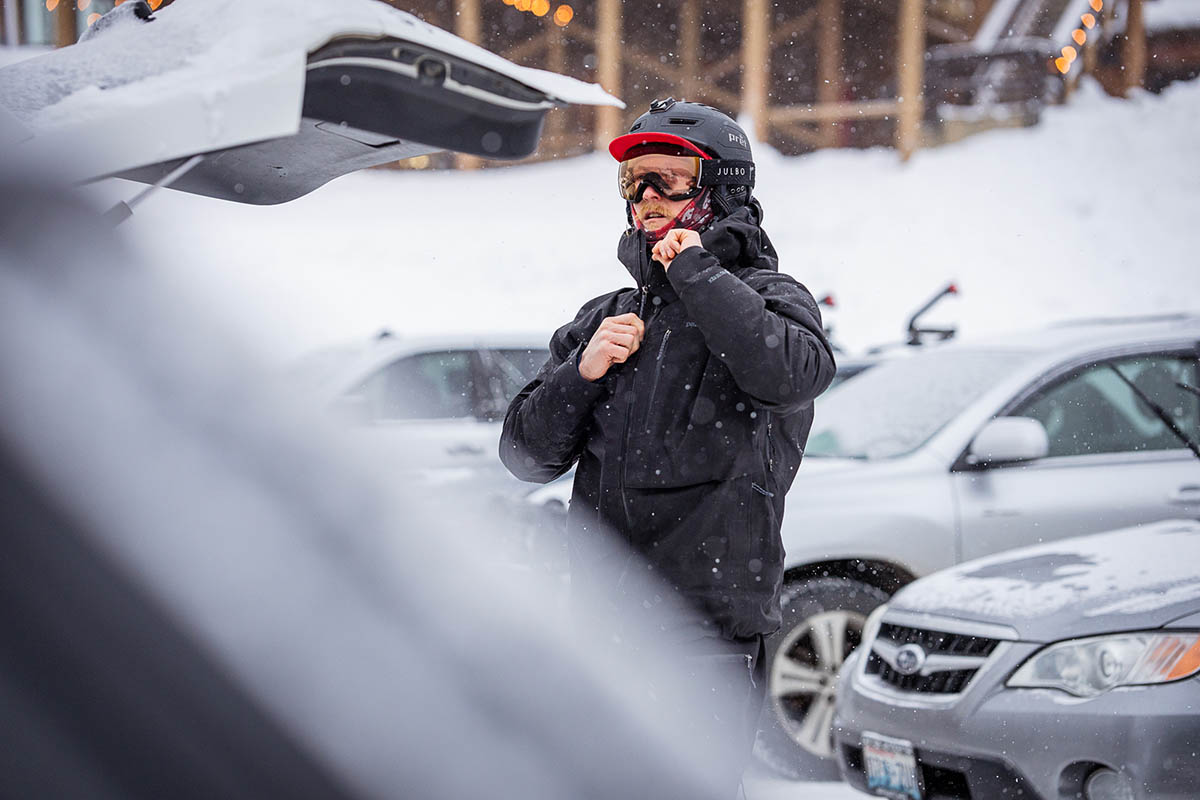
Ski jackets often are designed for a specific purpose—resort, backcountry, or a mix—so we’ve included a “best for” listing in our specifications and table above. Most skiers spend at least a little time on a chairlift, and as a result, most ski jackets accommodate those needs. Specifically, a resort shell should be durable, highly wind- and waterproof, feature functional organization, and have a fit that can accommodate layers of varying sizes underneath. Insulation is optional for resort-goers but a bad idea for most backcountry uses.
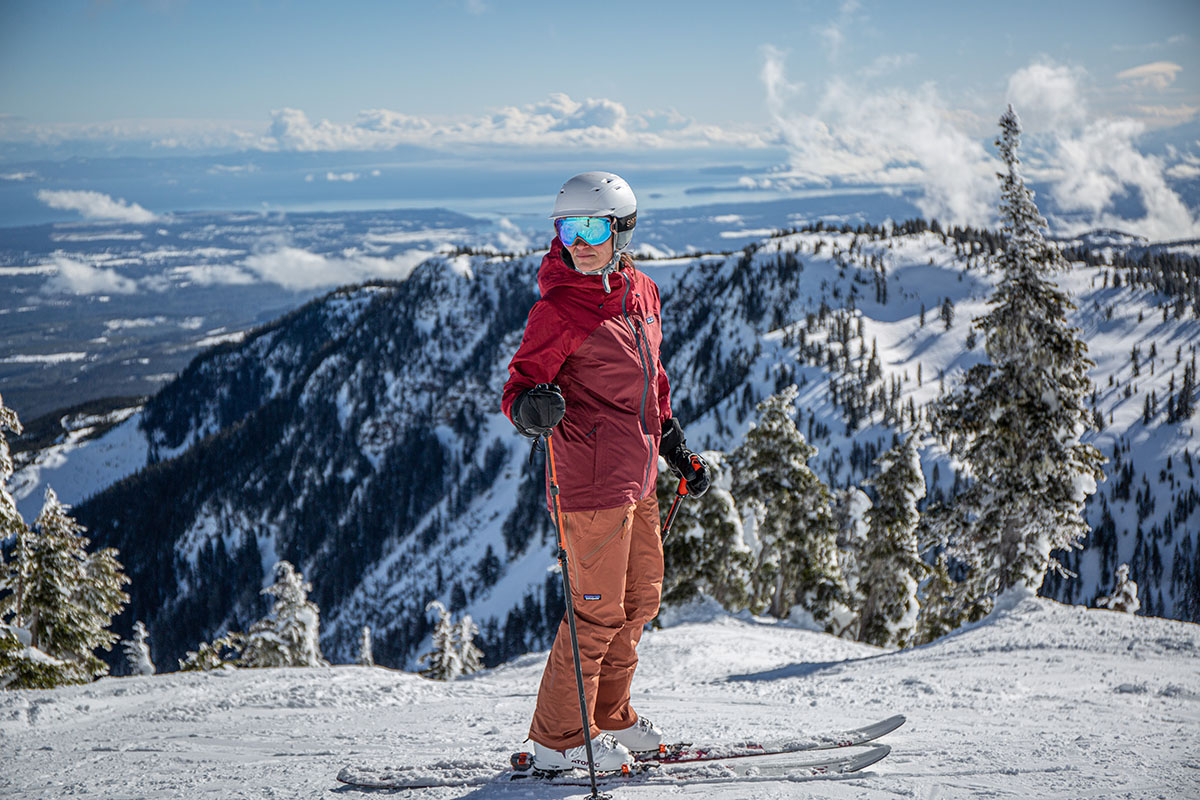
For ski touring, ski mountaineering, or sidecountry hikes, a non-insulated and lightweight design takes precedence. The fabrics need to be thin and packable, which impacts durability, and there is a high priority on mobility and staying cool. Breathable softshell jackets lead the pack in comfort for fair-weather days, but in heavy wind and moisture, a premium hardshell still is best (we cover the various shell constructions in more detail below). Fit does vary by use—freeride shells are roomy while touring-specific models fit more snugly—but all designs focus on maximizing range of motion. The jackets that toe the line of backcountry and resort use—including our top-rated Arc'teryx Sabre SV—have a great fit, reliable construction, and fabrics that balance wind- and wet-weather protection with breathability.
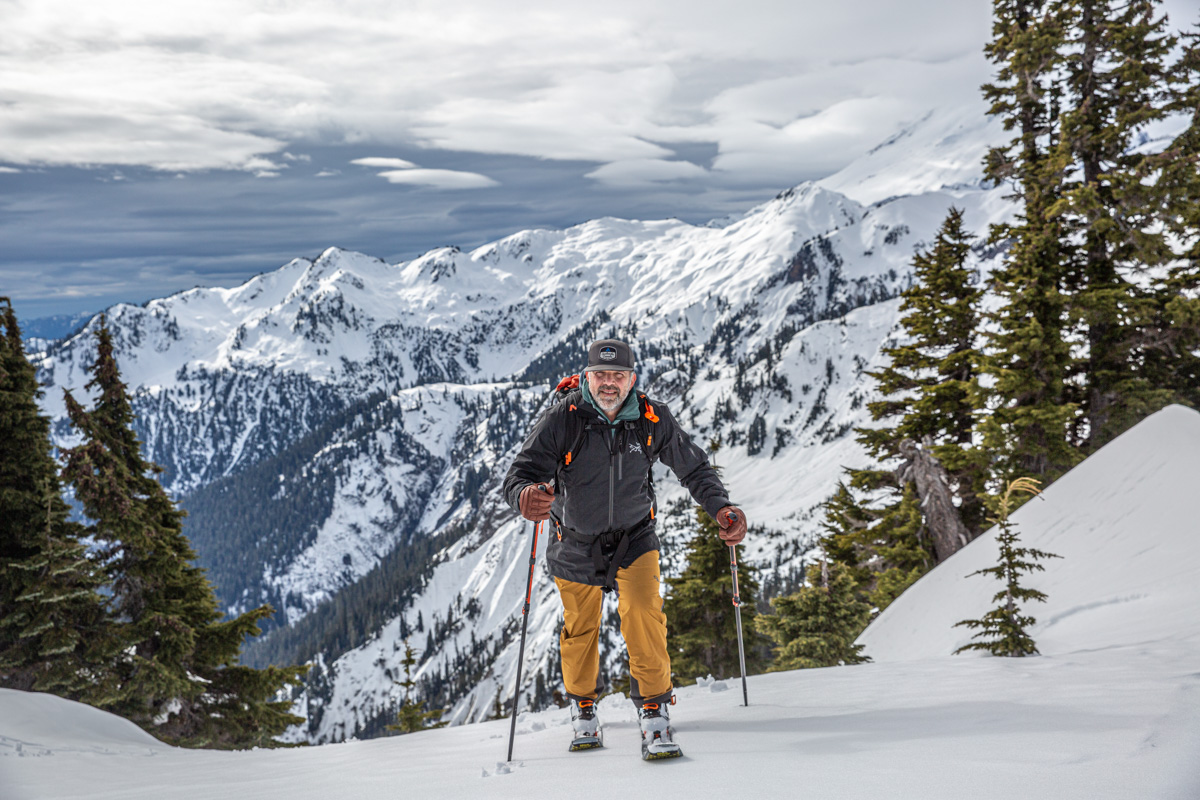
Closely tied to the “best uses” above is a ski jacket’s construction type. Here, the market can be broken into three main categories: shell, insulated, and 3-in-1. Choosing the right model depends largely on your skiing style and budget. The most popular is the shell, which is a versatile choice for everyone from casual resort skiers to backcountry adventurers in harsh, wet environments. Insulated jackets are ideal for inbounds skiing in deep winter, while 3-in-1 jackets are a good choice for budget-seekers and those just building their kit. Below is a quick breakdown, and for a deeper dive, check out our article on ski jacket types.
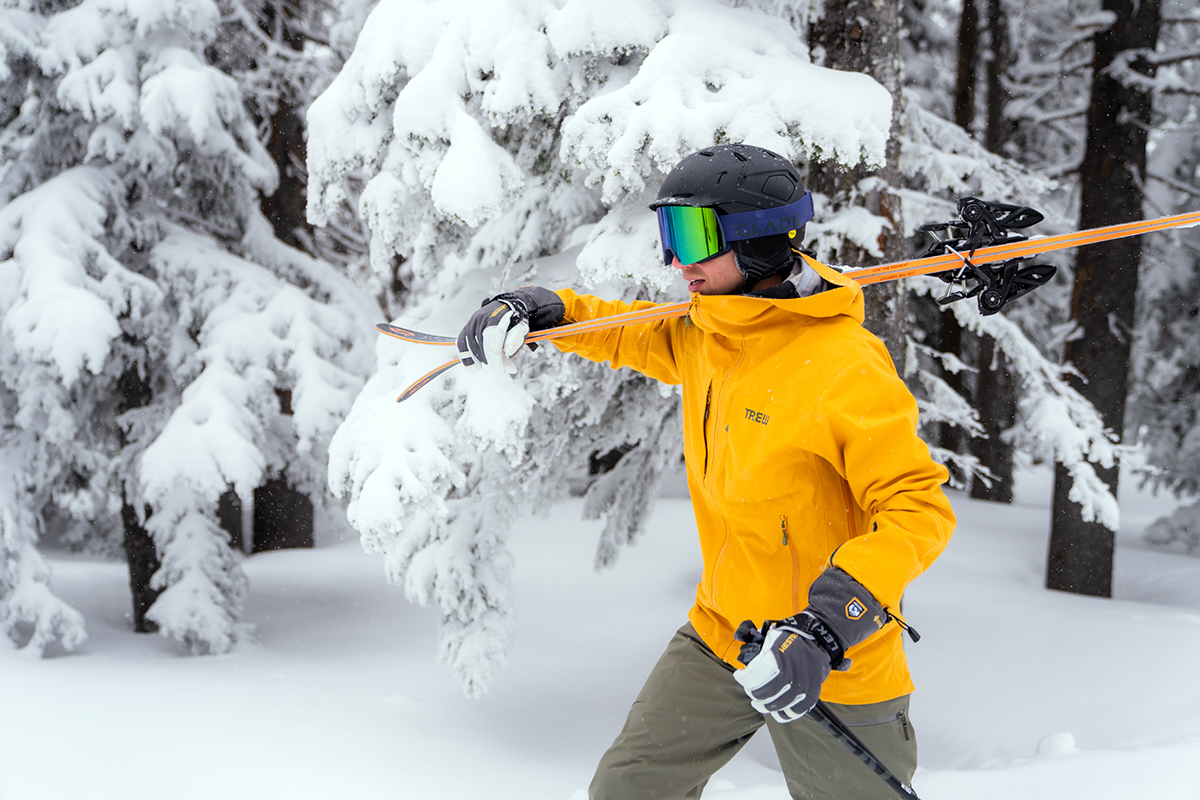
Shell (Non-Insulated) Jackets
Shell jackets offer sturdy protection from wind and moisture and can be suitable for both backcountry and resort use. Made with multiple layers of fabric laminated together, they are typically waterproof, windproof, and at least modestly breathable. By our definition, these jackets are not insulated, so you’ll want to pair them with a baselayer (and usually midlayer) for warmth.
High-end shell jackets like the Arc’teryx Sabre SV have premium waterproof/breathable membranes (Gore-Tex, Patagonia’s H2No, and Outdoor Research’s AscentShell are three of our favorites) and a tailored fit for excellent range of motion. Some feature rigid and crinkly hardshells, while many modern backcountry designs incorporate a stretchy face fabric or panels of softshell, which provide great mobility and breathability but less bombproof protection (for more, see our description of hybrid hard/softshells below). Basic shells use thicker fabrics and cheaper waterproofing that doesn't breathe as well. Beginning and occasional skiers will be fine with an entry-level shell jacket, but we do recommend spending up for active and aggressive skiers or those who get out a lot.
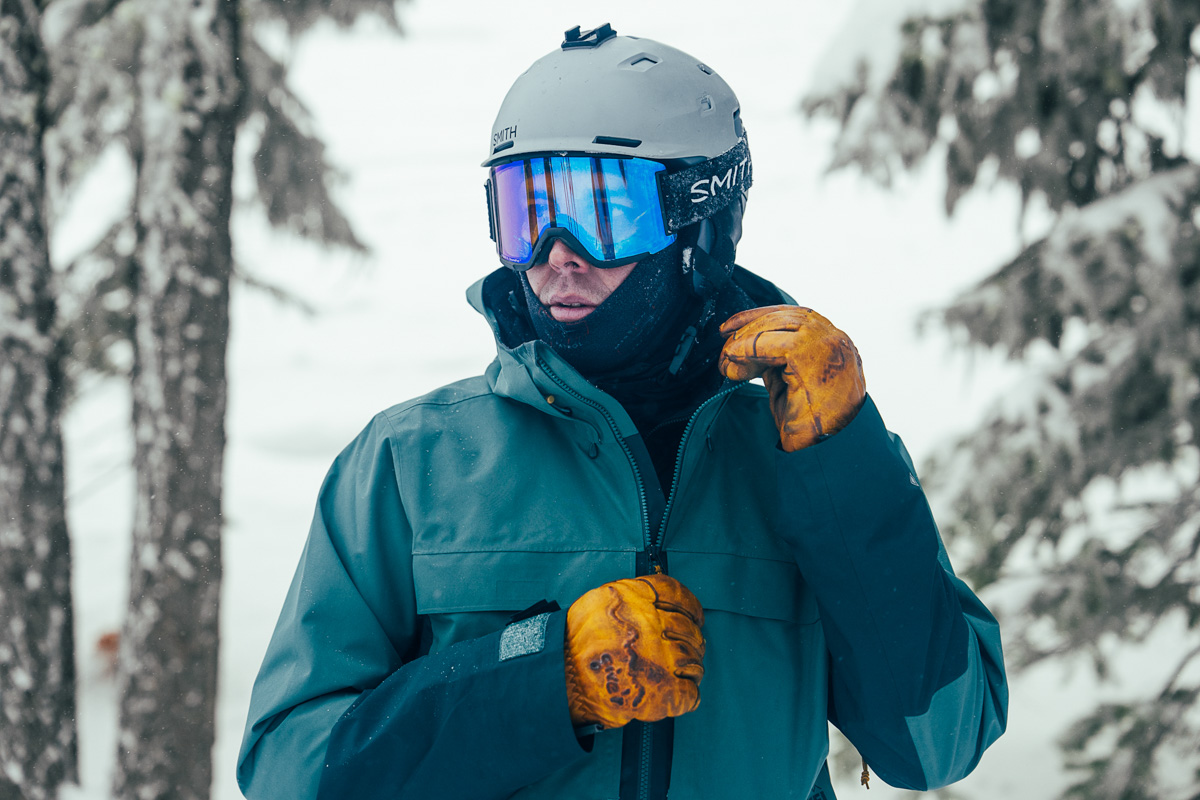
Insulated Jackets
Jackets in this category combine a weather-protective shell with built-in insulation, resulting in a great defense against both moisture and cold. We love these designs for resort-goers, who will benefit from the added warmth during cold chairlift rides and frigid downhill laps. Most insulated ski jackets feature synthetic fill—compared to down, it's cheaper, more breathable, and insulates even when wet. The most high-end varieties offer more warmth for less bulk (PrimaLoft Gold and Patagonia’s PlumaFill are two of the best), while budget designs will be heavier, bulkier, and tend to overheat in a hurry. Regardless of the type of insulation, keep in mind that these jackets are inherently heftier, less breathable, and offer less range of motion than shells, which isn’t a big issue for inbounds use but can be a deal-breaker for most backcountry skiers.
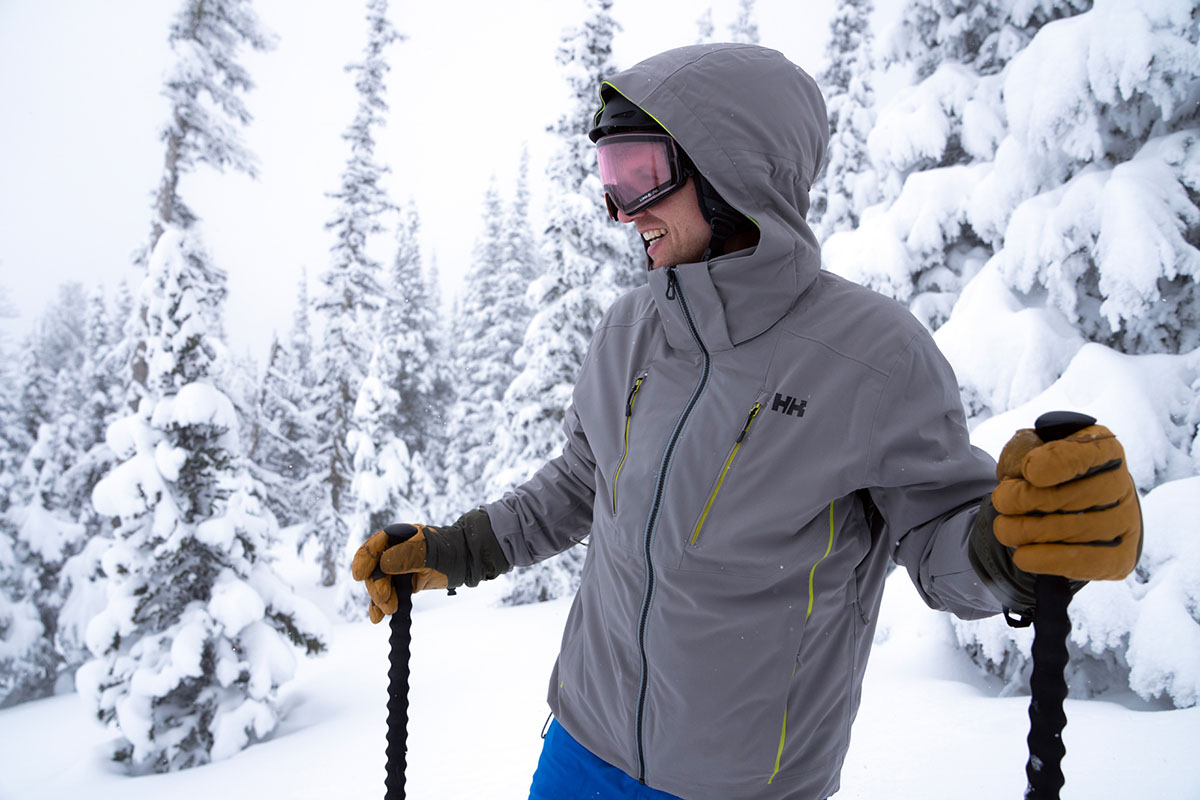
If you opt for an insulated model, it’s a good idea to carefully consider how much warmth you need. Most jackets feature a heavy dose of insulation in the body with thinner fill in the arms and hood. A thick and substantial option is a dream in the cold, but will run hot on mild-weather days which can be a problem for season-long use. As such, we typically prefer moderate levels of warmth, such as REI Co-op's Powderbound or Helly Hansen’s Alpha 4.0 (both 80g and 60g). These jackets give you the flexibility to add a midlayer if the mercury really drops without overheating when the sun comes out and temperatures rise midday. There’s certainly a time and place for a heavily insulated model, but most skiers will be better off with a more balanced design.
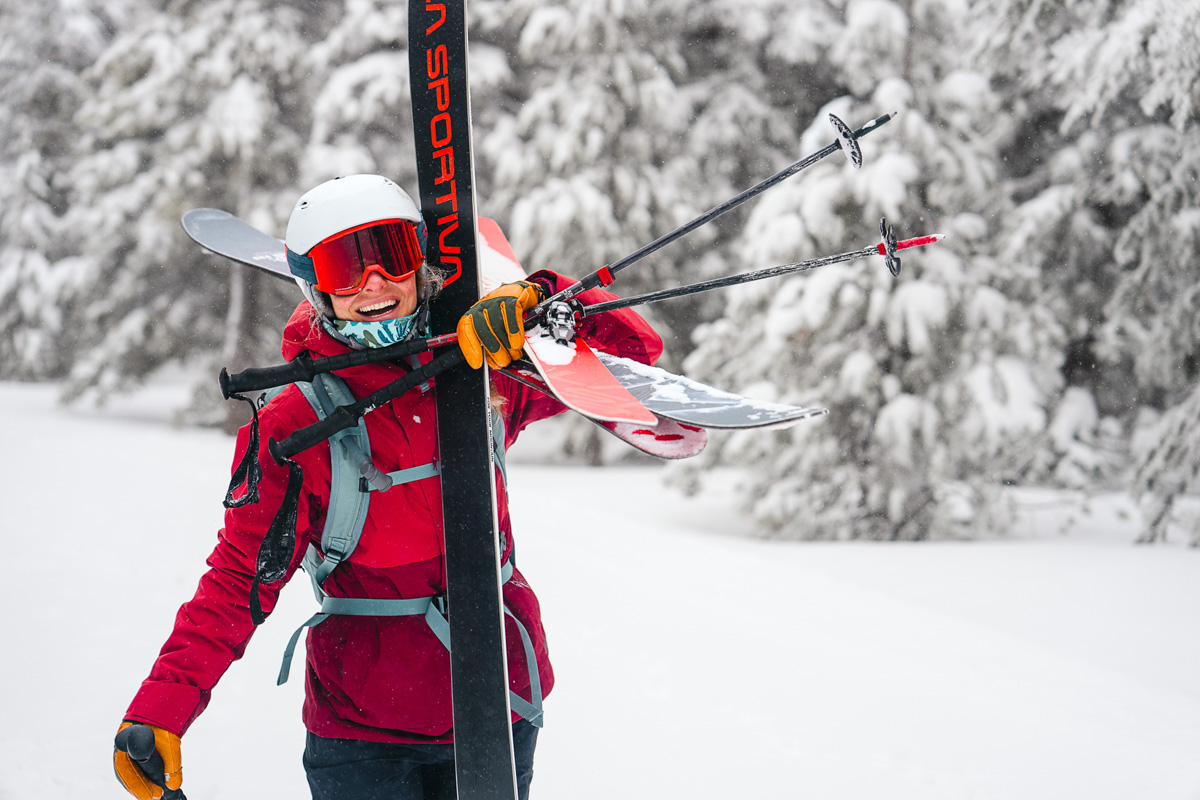
3-in-1 Jackets
With an outer shell and zip-in insulated layer, 3-in-1 jackets are extremely popular for casual skiers. The main advantage is cost: You can pick up a good 3-in-1 jacket for around $200 to $400, and—as the name implies—you get the versatility of three jackets in one. Wear the shell sans insulation on warm spring days, zip the two together mid-winter, and don the midlayer (most often a fleece or synthetic jacket) for everyday use. Versatility is unparalleled, and, unlike insulated models, you can leave behind the warming layer simply by unzipping it.
3-in-1 jackets do add bulk and weight with the extra zippers, and integrating the shell and insulating layer negatively impacts range of motion (we’ve also found it also makes them prone to being drafty). Further, you can’t access the midlayer’s pockets when it’s zipped into the shell, weather protection is often middling with cheap materials, and these jackets are far from the best performers for high-exertion activities (opting for one with pit zips is suggested). Nevertheless, for the budget-seeker or skiers that only make it to the mountain a couple times a year, a 3-in-1 like the Columbia Bugaboo Interchange is a good way to get kitted out for a reasonable price.
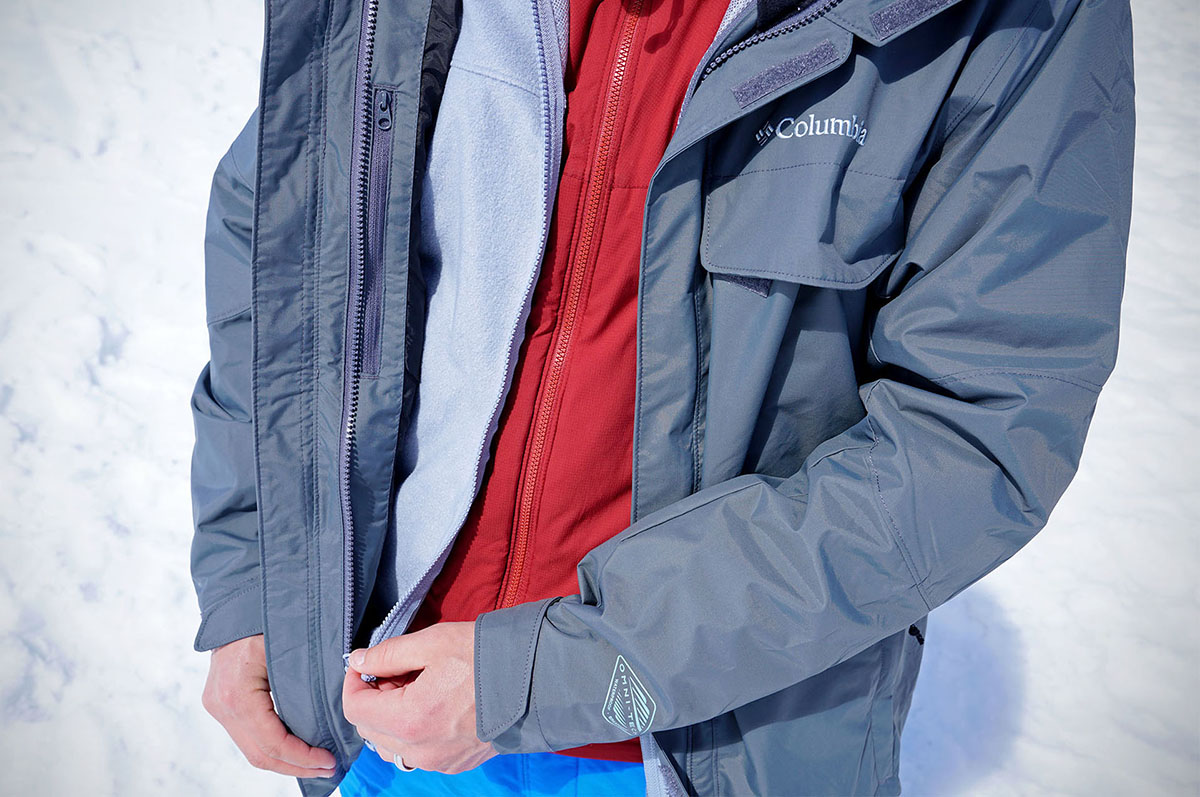
A subset of the “shell” category above, softshells and hybrid hard/softshells have appeals for high-exertion activities like ski touring. Pure softshells lack a waterproof liner and are the clear leaders in mobility and breathability as a result. Their woven exterior fabrics have a generous amount of stretch, let air flow in and out to help with temperature regulation, and they lack the crinkly and stiff feel of a hardshell. Their main downside is weather resistance, or lack thereof, which limits their appeal to fair-weather backcountry skiing (they’re especially popular in regions with dry snow). We don't include any dedicated softshells on the list above—Black Diamond's Dawn Patrol Hybrid does use a stretchy 2-layer softshell material around the underarms and lower body—but for a full look at options, check out our article on the best softshell jackets.
Hybrid hard/softshell designs take the stretchy fabric of a softshell and incorporate a waterproof membrane for a big boost in weather protection. Jackets like Black Diamond’s Recon Stretch, Outdoor Research's Skytour, and Flylow's Malone are noticeable more comfortable, breathable, and less restrictive than a Gore-Tex hardshell. That said, we’ve found this hybrid concept still can’t match a standard hardshell in terms of all-out protection in very wet and rough conditions. In particular, their face fabrics are more prone to absorbing moisture, and they don’t have a bombproof feel in very high winds. But for the right use and the right environments—and especially for those looking for a one-shell answer for mixed resort and backcountry use—hybrid hard/softshells can be a great choice.
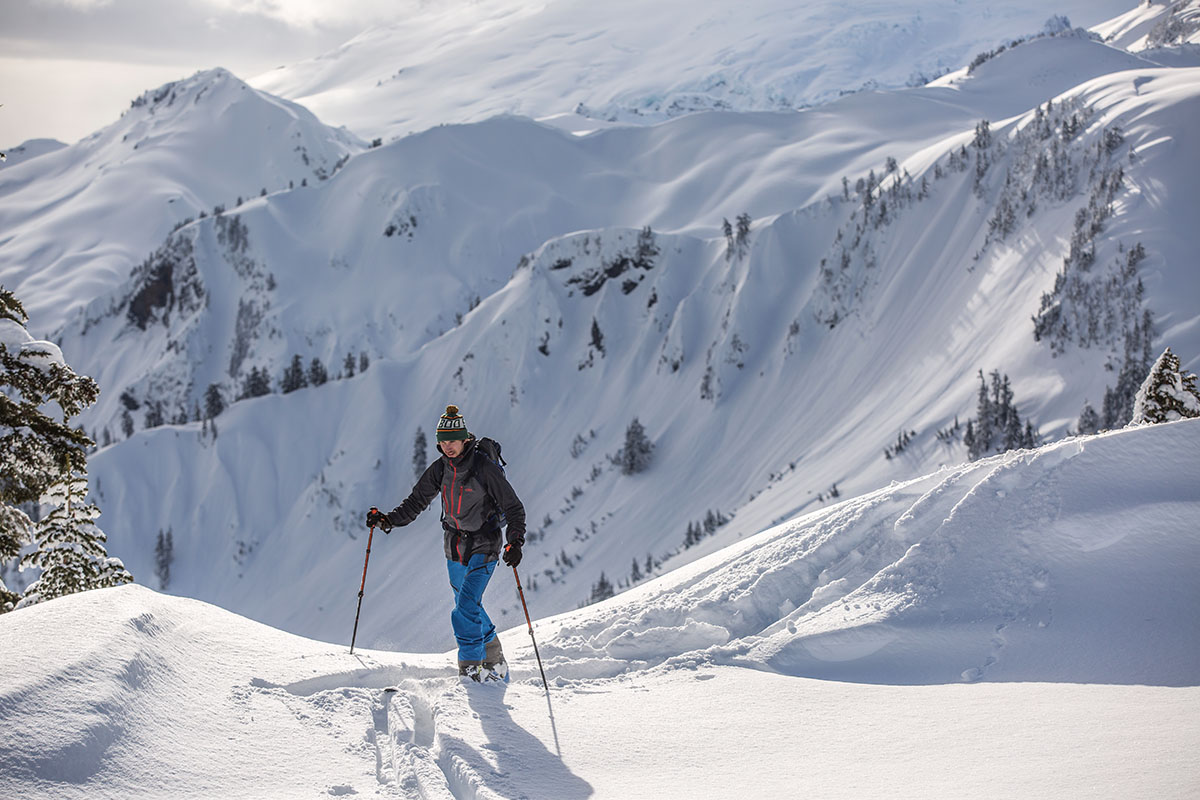
One specification you’ll consistently run into as you research ski jackets is the number of fabric layers (either 2L or 3L). This feature points to construction: A 2-layer jacket bonds the exterior face fabric to a waterproof membrane and has a separate liner along the interior (often mesh), while a 3-layer build connects all three pieces together. In terms of cost, 2-layer models are often found on entry-level to mid-range options, including REI Co-op's $199 Powderbound and Patagonia’s $399 Insulated Powder Town Jacket. Stepping up to a 3-layer design usually means a price tag north of $400 or $500.
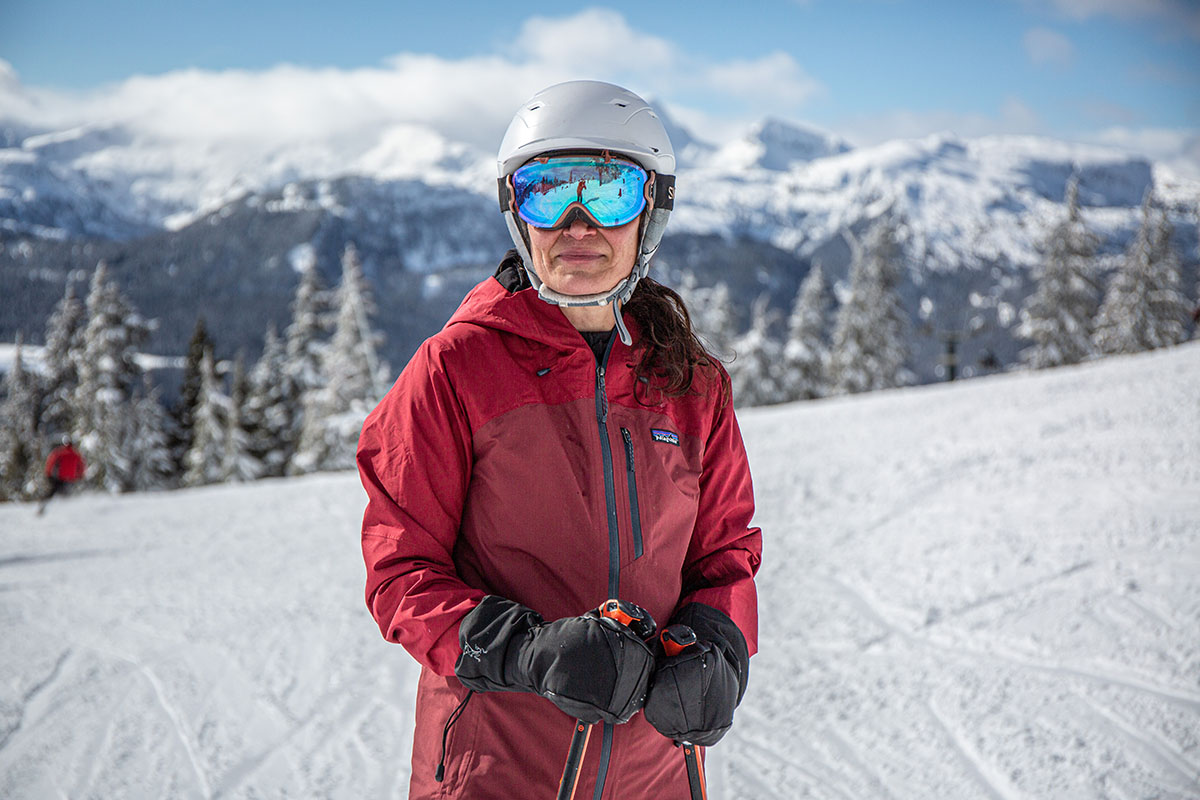
How do the construction types differ in terms of performance? Starting with 2-layer jackets, these are popular among resort riders as they offer solid weatherproofing and durability at a good value. Downsides are that 2-layer jackets aren’t very breathable, and the extra hanging liner adds both weight and bulk. Active resort and backcountry skiers often choose a 3-layer build for its improved range of motion, comfort, and lighter weight. In addition, 3-layer jackets breathe reasonably well and high-end Gore-Tex-equipped models are market leaders in protection in the harshest conditions. If you stick to the resort, either a 2- or 3-layer build can do the trick, but we recommend a 3-layer option for the ski touring crowd. For an in-depth look at the topic, check out our article Ski Jacket Construction: 2L vs. 3L.
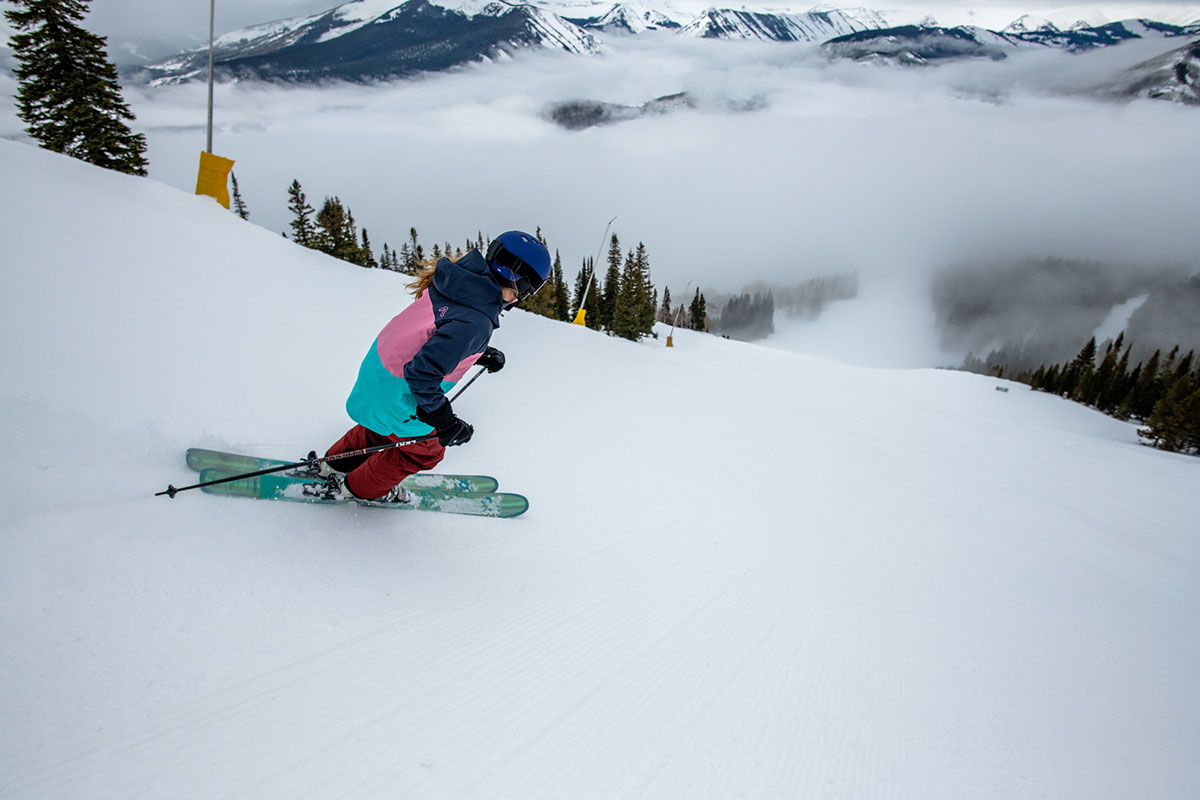
Ski jackets are waterproof pretty much across the board, from cheap $100 options all the way up to high-end Gore-Tex (or equivalent) shells. One exception is a backcountry-specific softshell, which may have seam taping but will eventually let in moisture. Among waterproof options, spending more will get you a longer lifespan, on average, as the more advanced fabrics aren’t as prone to deteriorating. Those that get out a lot or are deep in the backcountry in serious conditions should consider investing in a burly Gore-Tex Pro shell like the Arc'teryx Alpha SV. The shell fabric and waterproof membrane are very impressive performers in brutal wind and snowfall. Most resort skiers, however, will be just fine with an entry-level option like the Columbia Bugaboo Interchange. Finally, look for a jacket with a DWR (durable water repellent) coating, which helps shed wet snow to keep moisture from sitting on your jacket and wetting through the outer fabric.
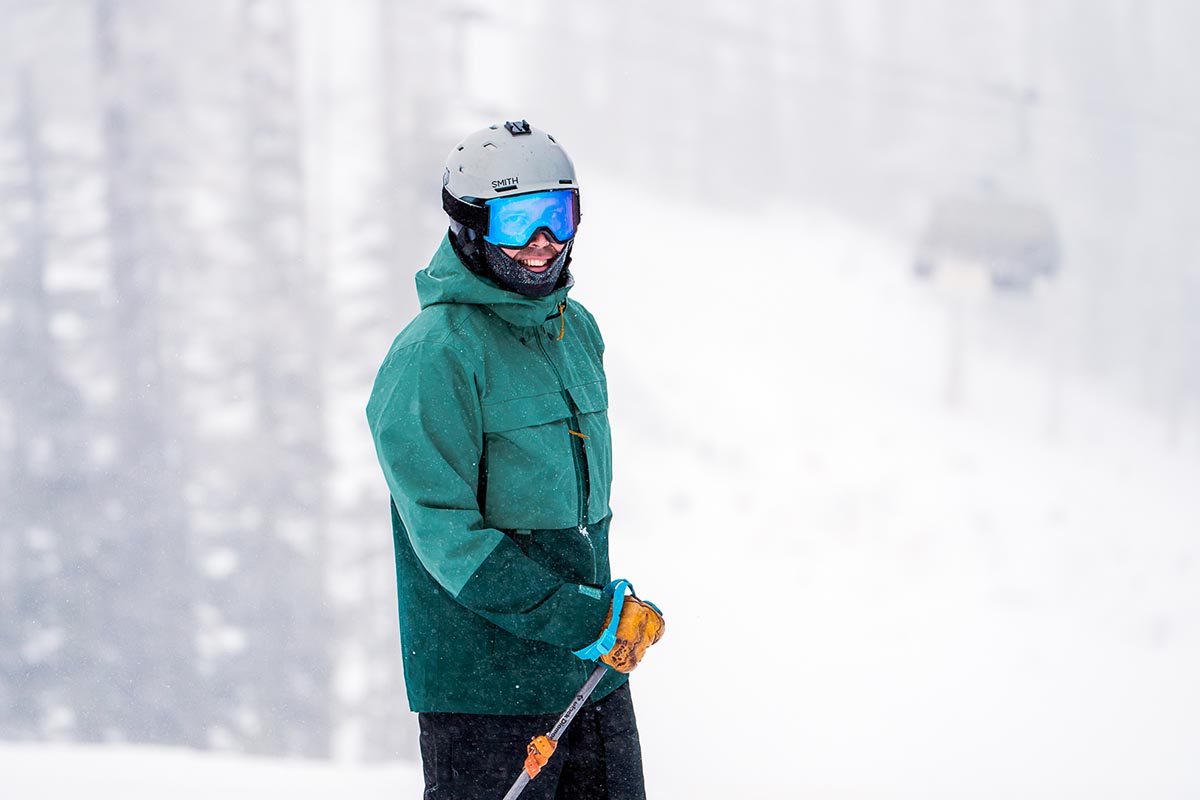
Breathability ranks as a top priority for backcountry use, and a little less so with downhill skiing. While you can absolutely work up a sweat on your way down the mountain, it’s easy to dump heat with pit zips or dropping a layer at the resort midday (so long as you can survive the chairlift ride minus some insulation). Shell jackets are the best breathers, and those with a high-end 3-layer fabric construction (Gore-Tex, eVent, Polartec NeoShell, Proflex, or OR's AscentShell) are head and shoulders above the rest for waterproof jackets. Generally, the more you spend on an uninsulated hardshell, the better the breathability. Softshells are the all-around leaders because they don't have to deal with the waterproofing layer, but the clear downside is wind and water resistance.
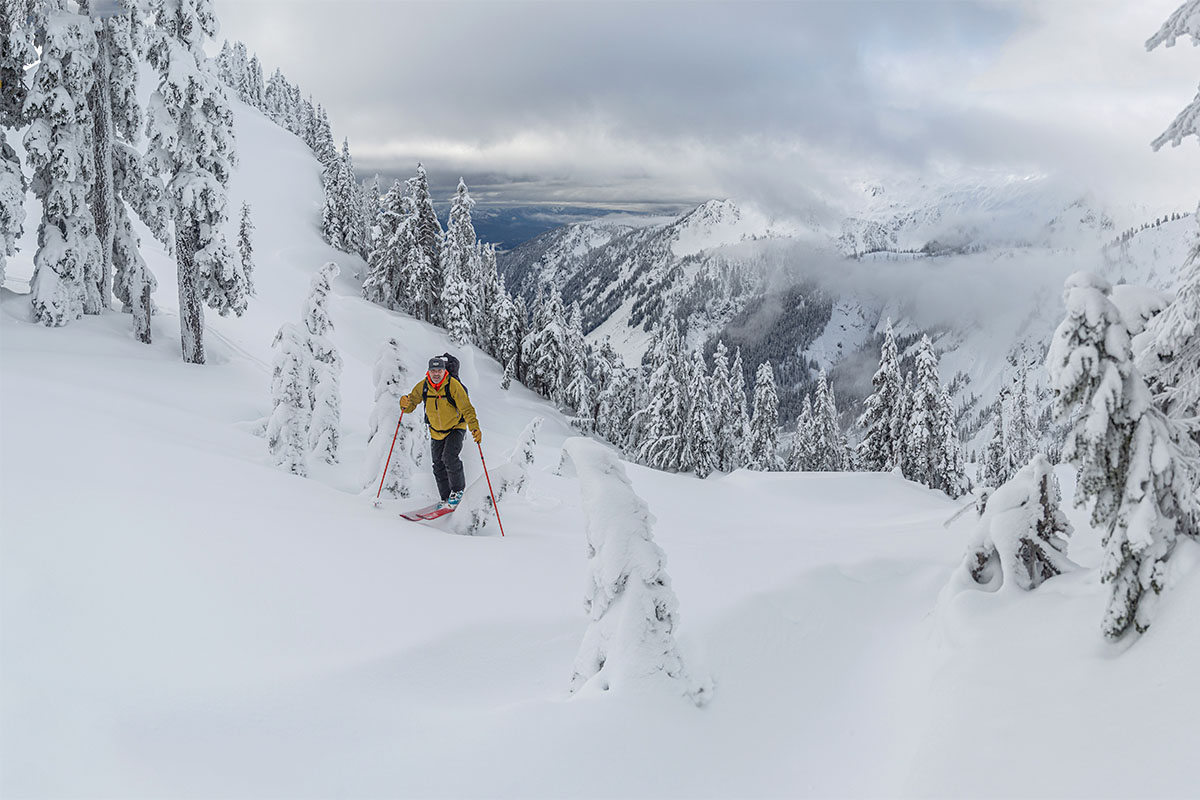
Skiing is a rough sport—everything from getting on and off the lift to hiking and riding off trail can wreak havoc on gear—so your outer layers are often quite durable. Denier, or “D,” is how fabric thickness is measured, and a higher number correlates with a more substantial build. Overall, resort skiers are best off with a burlier construction, and some of our favorites are about 100D and up (including the very burly 200D x 320D Trew Gear Tatoosh).
If you prioritize a lighter setup for mobility but still want something tough, jackets with about 80D are a nice compromise. And finally, backcountry shells are often the thinnest for weight savings, with popular jackets ranging from just 20D (the Rab Khroma Kinetic) to about 70D (or higher, in the case of the 100D Arc'teryx Sabre SV and Alpha SV). Some designs also use blends of fabric thicknesses to reinforce high-wear areas. The Arc'teryx Beta AR, for instance, boasts a 40D shell fabric with thicker 80D at the shoulders and hood. It’s worth noting that some manufacturers do not provide this specification, but you can make some safe assumptions based on intended use: Expect a thicker build with a resort shell and a bit less durability for active and touring designs.
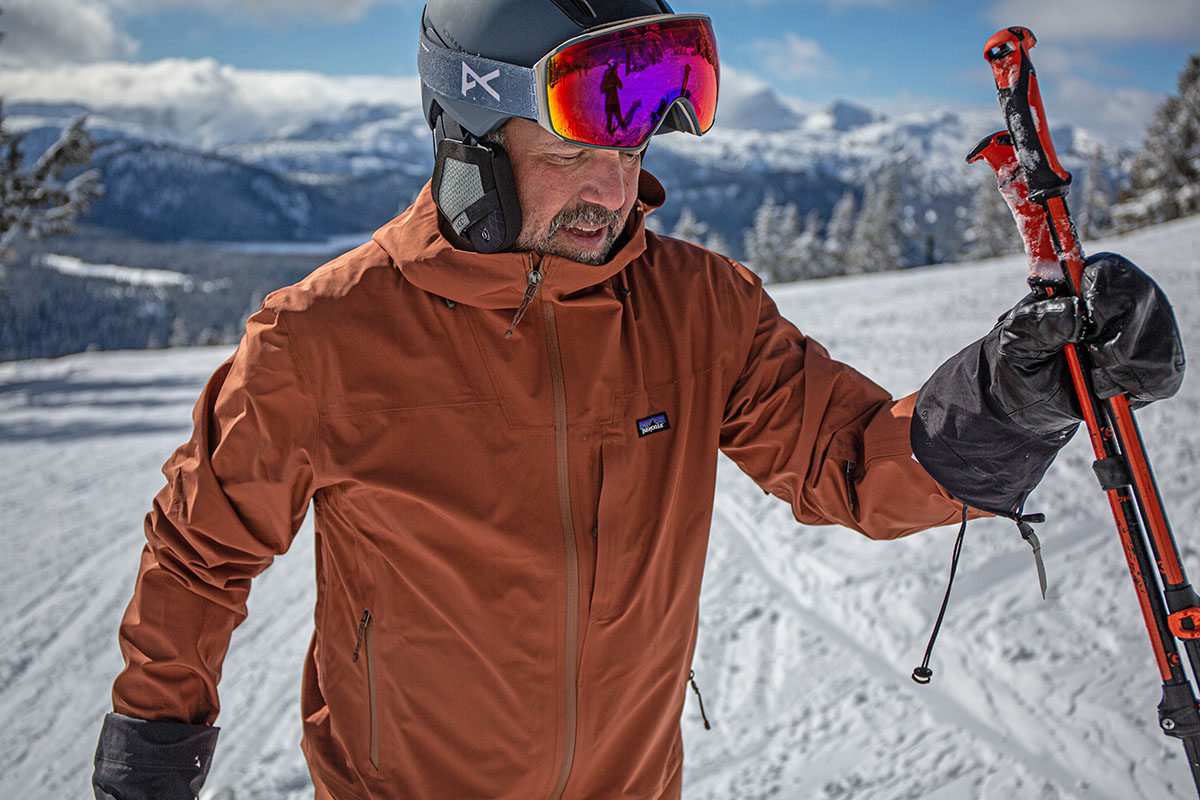
The outdoor apparel world has seen a sizable uptick in the use of sustainable practices in recent years, and ski jackets are no exception. Two key measures include recycled materials and PFC-free DWR coatings (traditional coatings use per- or polyfluorinated chemicals—"forever chemicals" known to be harmful to the environment). With many states stepping up to ban the sale of items that include PFCs, the outdoor industry is seeking better solutions for water- and stain-resistant finishes (for more, you can read about Patagonia’s take on the issue). Bluesign-approved fabrics are also becoming more common, indicating that the materials have been sourced and produced to minimize their overall impact on the environment. Finally, many companies make products with a Fair Trade certification, which helps ensure the fair and ethical treatment of workers.
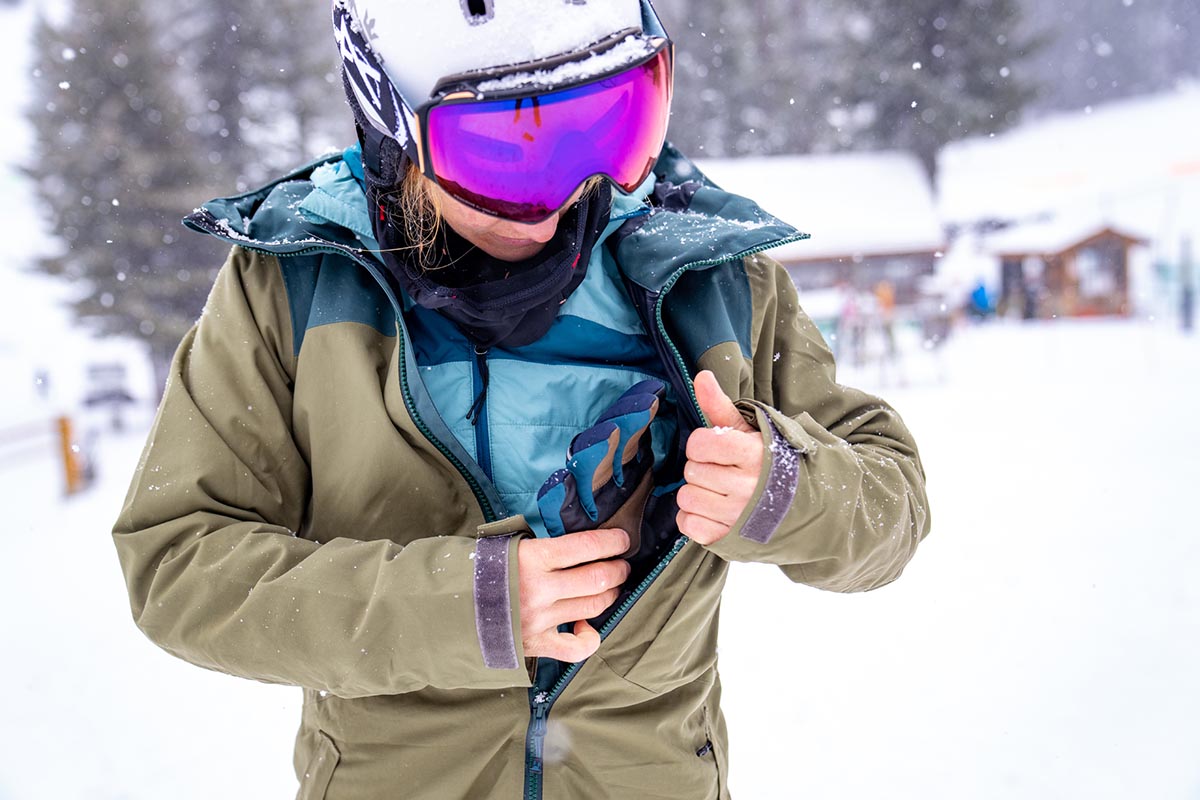
The good news is that most sustainability-conscious brands are transparent about these practices and clearly indicate which (if any) measures each product uses. Patagonia is a clear leader in this realm: Their Powder Town jacket, for example, is Fair Trade Certified, features 100%-recycled liner, insulation, and shell, and has a PFC-free DWR finish. Several other brands are also making strides, including Arc'teryx, REI, and more. There’s still a long way to go in the industry, but the current trajectory and momentum from many of the key players are encouraging. And of course, a final way to shop sustainably is to purchase quality products that will last and repair old gear rather than buy cheap items that will need to be replaced in a season or two.
For resort skiers, the weight of your ski jacket isn’t usually a deciding factor. As long as you’re comfortable, it’s easy to handle a few extra ounces without really noticing (even the 2-lb.-8.8-oz. The North Face ThermoBall Snow Triclimate isn't excessively heavy for the typical ski day). On average, cheaper jackets compensate for their less advanced fabrics by using more of it, making for thicker, durable shells. It’s when you start hiking or venturing off trail that a lighter jacket starts to make a lot of sense. This is when a dedicated, lightweight hardshell may be the ideal choice for your skiing needs. Standouts in this category include the Arc'teryx Alpha SV (1 lb. 1.1 oz.) and Rab Khroma Kinetic (1 lb. 2.9 oz.).
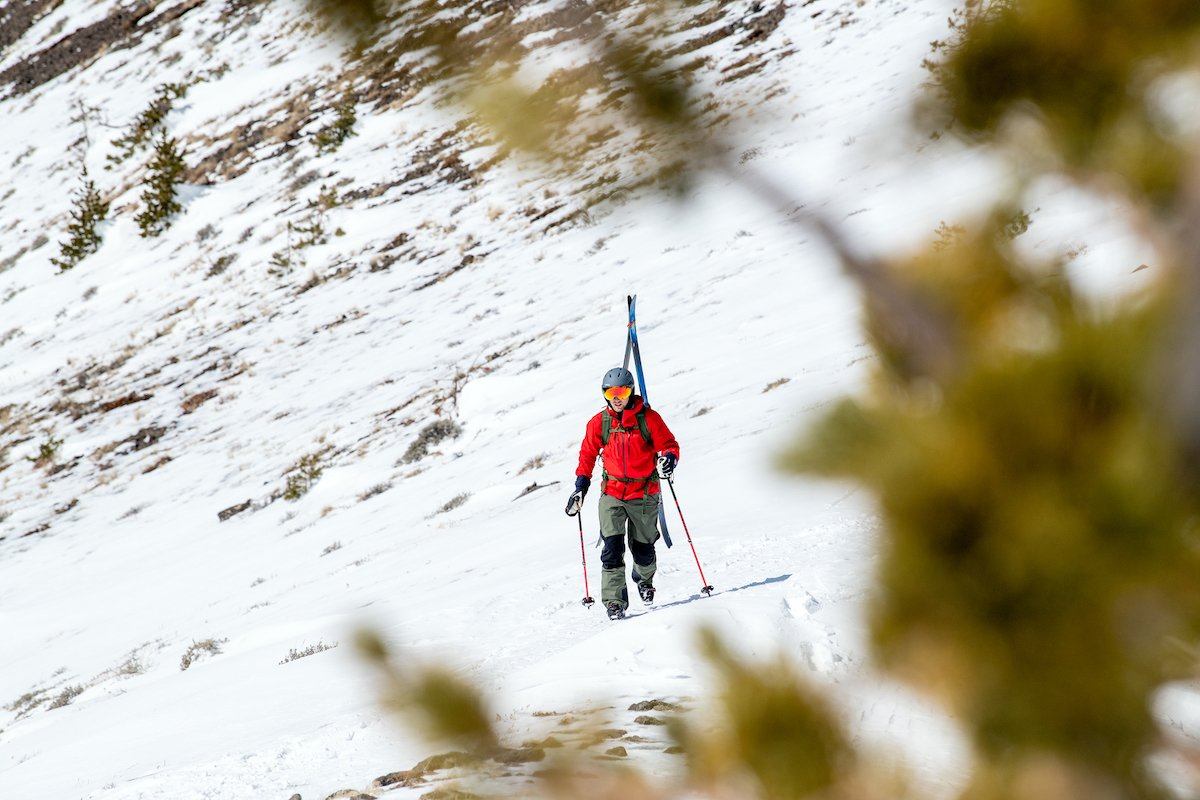
Hoods
Most hoods go unused for downhill skiing—a helmet is a fine source of protection and insulation. It’s most often on the chairlift when you really need to hunker down does the hood come out. For those particularly nasty days, make sure to get a hood that is large enough to fit over your ski helmet. And not only does it have to be large enough, but it also needs to be plenty adjustable to cinch down and stay pinned to your head while skiing. A properly adjusted hood should not interfere with your field of vision as a good safety measure. Finally, should you want to use your ski jacket for more than just skiing, ensure that your hood fits well when you’re not wearing your helmet.
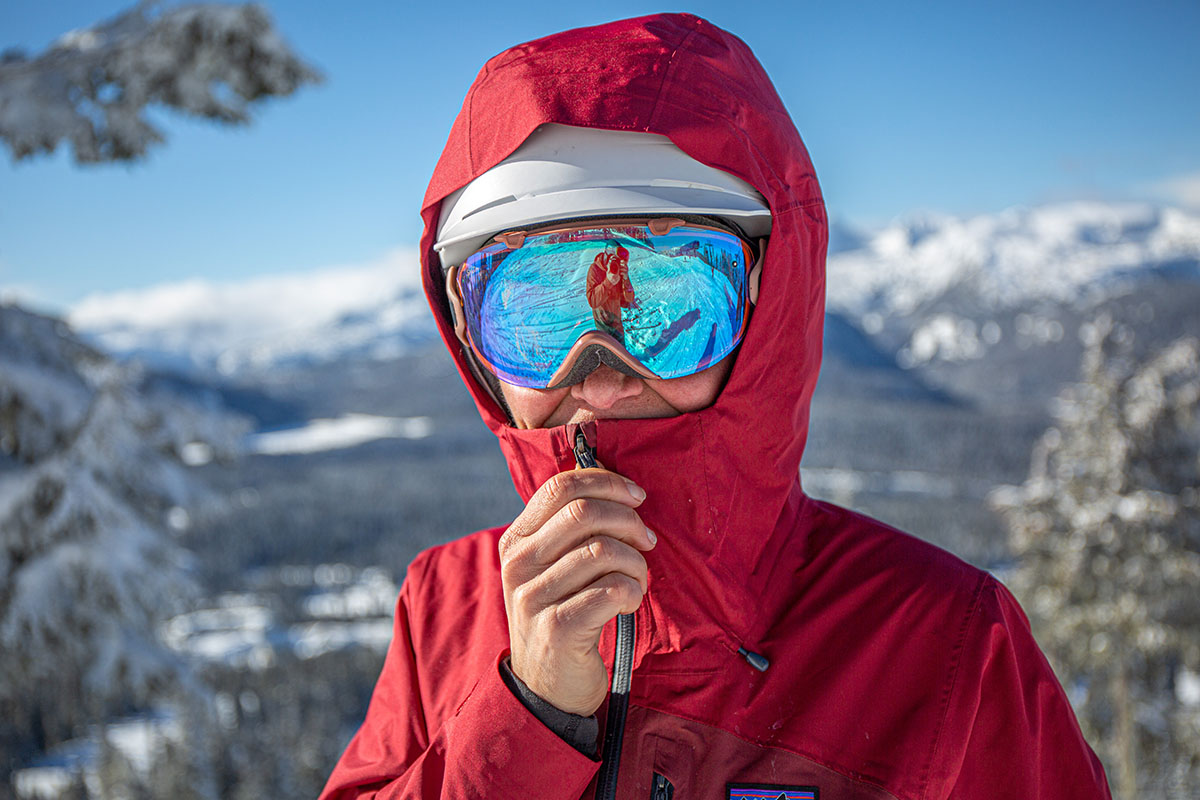
Pockets
Unless you ski with a backpack, it’s important to select a jacket with multiple pockets. Most ski jackets include a couple of hand pockets and at least one zippered Napoleon pocket at the chest. That Napoleon pocket is great for stashing smaller items like a phone, camera, or wallet. To protect your electronics, it’s good to have a chest pocket along the interior of the jacket so your body heat can help keep everything functioning properly (the “Life Pocket” on the Helly Hansen Alpha 4.0 is specially insulated to limit battery drain on your electronics). If you listen to music while on the mountain, look for a chest-height pocket with an interior opening to feed your headphone cord for a clutter-free setup.
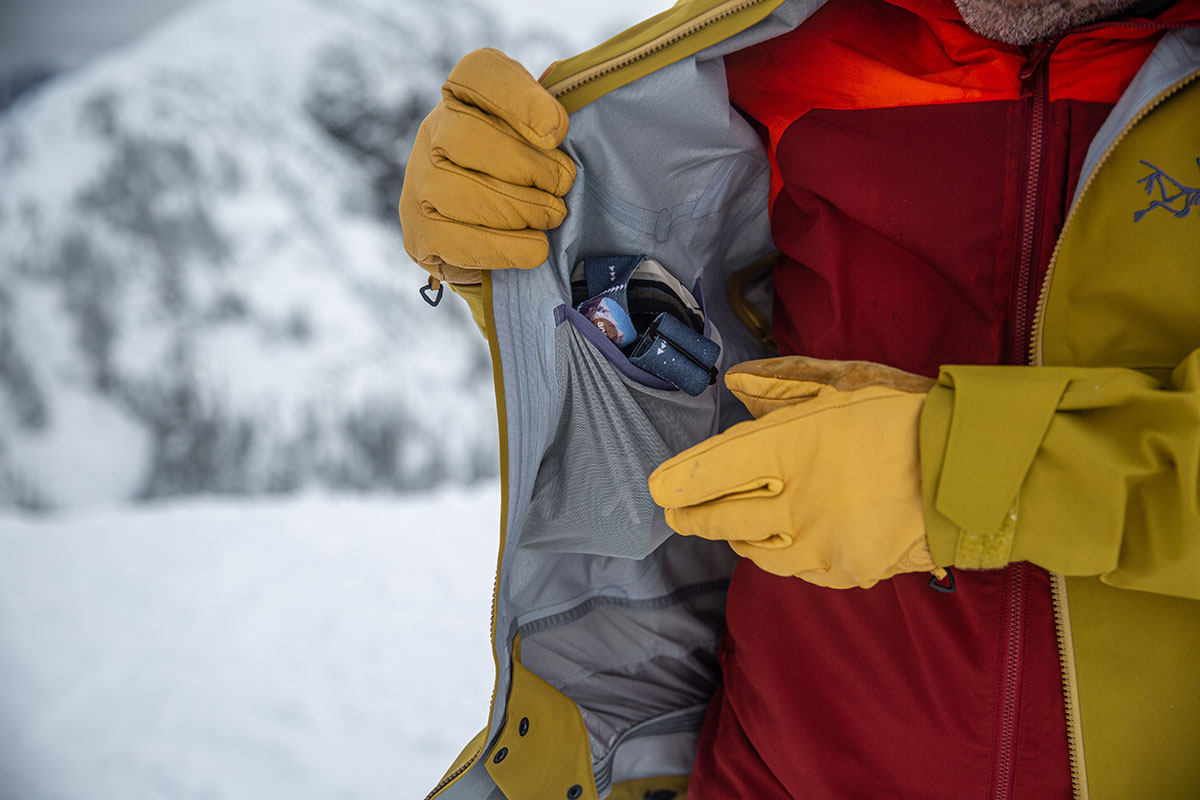
Other useful storage options include mesh hanging pockets built into the jacket’s inner lining. These serve as a nice place to stash your gloves, goggles, or glasses in between runs or if you’re starting to overheat while hiking. Further, they’re a practical choice for backcountry skiers that want to store their climbing skins on a short descent. Finally, you’ll see a number of resort-ready models include a sleeve pocket on the left arm, which allows for both easy access to your ski pass and compatibility with RFID passes and electronic gates.
Powder Skirts (Snow Skirts)
It's nearly impossible to keep the snow completely out should you ski through some really deep snow or take a serious tumble, but a powder skirt nonetheless is a great line of defense. Elasticized fabric is built into the lining of the jacket around the waist, and will typically secure to your ski pants near the front zipper. This helps snow from entering in the space between your pants and the bottom hem of the jacket. Some manufacturers make the snow skirts removable should you want to use the jacket around town.
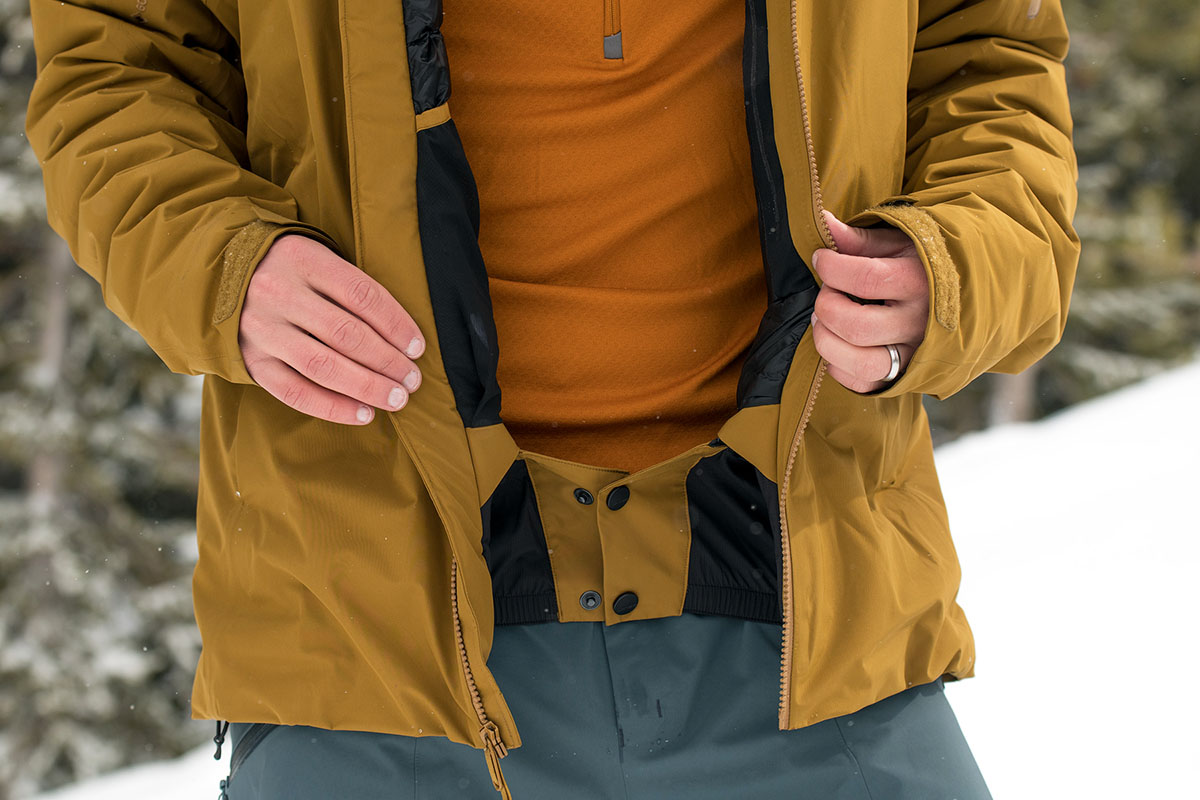
Jacket-to-Pant Attachment Systems
Like the powder skirt, jacket-to-pant attachment systems are all about maximizing protection and warmth. Designs don’t vary significantly within the ski market, and most utilize a simple button on the powder skirt that secures to a corresponding piece on the pant (in the case of Patagonia, this is a fabric loop). The upside in connecting your outer layers is creating an even more solid seal from the wet and cold, but it’s certainly not a required feature for either resort or backcountry use. It’s worth noting that in nearly all cases, you’ll need to purchase a pant from the same brand for the interface system to work. And many manufacturers, like Outdoor Research and Black Diamond, skip the feature altogether.
Pit Zips
Skiing can be a high exertion activity, and waterproof jackets, no matter the quality, restrict airflow. Enter the pit zip. Open them all the way, extending from approximately the middle of your ribcage to just above your elbow, and you can release a whole lot of hot air. Although they’re not a necessity for the easygoing skier and do add a bit of weight and bulk, we recommend putting pit zips on the active skier's “must have” list when jacket shopping. One design that really stands out is Outdoor Research's Hemispheres II (not included here), which has pit zips that extend all the way to the hem.
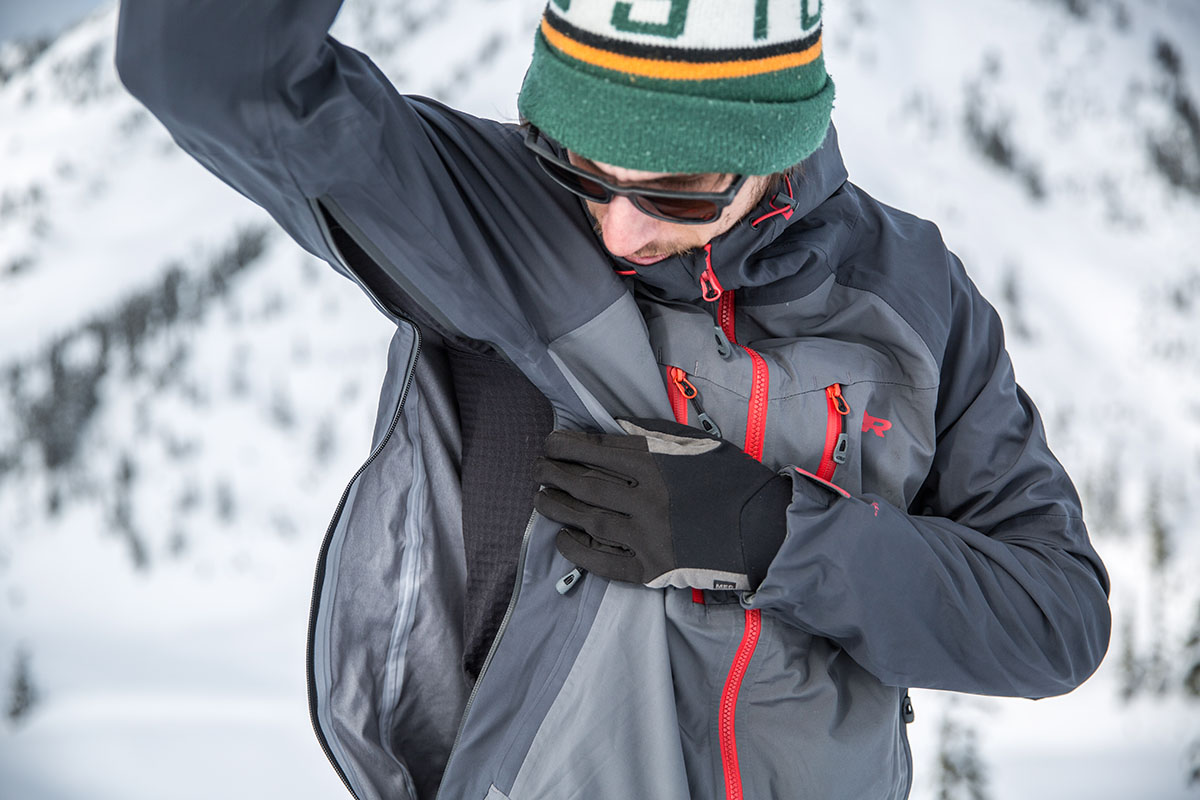
Recco
A Recco reflector is intended for skiers that make their way out of bounds or into areas prone to avalanches. Built into your ski jacket or pant, the reflector is a passive unit that doesn’t require batteries and can be picked up by Recco detectors sometimes carried by resort search and rescue. They have clear limitations and lack the technology and strong signal of a dedicated search and rescue beacon, but they do provide an additional safety measure should you venture off trail. For a deeper dive on the tech, we've found Recco's website to be a good resource.
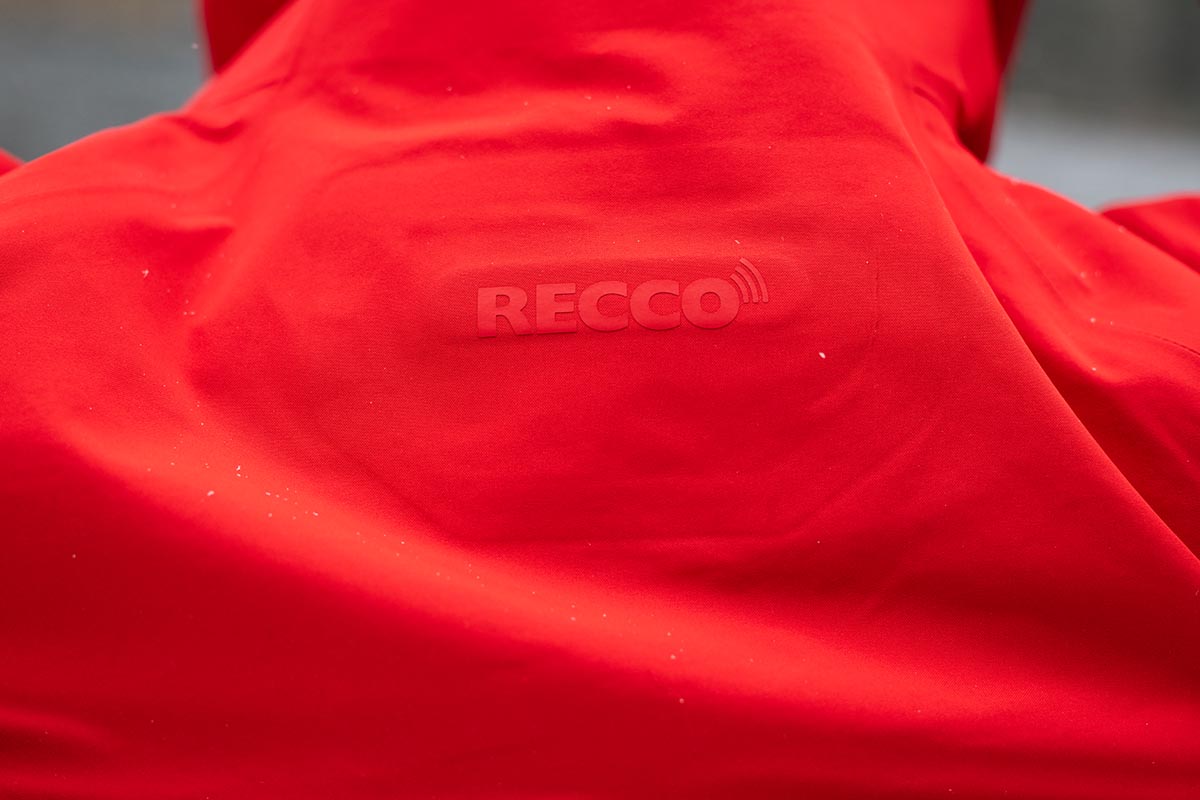
In general, the fit of a ski jacket will correspond with its intended use. Resort designs like Patagonia’s Powder Town have a roomy shape to allow you to wear a range of base and midlayers underneath. In addition, they have a long cut with a drop hem to provide protection from frozen chairlift seats. On the other end of the spectrum are backcountry-specific builds like the Black Diamond Dawn Patrol Hybrid, which are trimmed down to minimize bulk and improve range of motion. They’re snug enough to move with you comfortably on the skin track, but have just enough space to accommodate a puffy for transitioning and on the descent. Finally, an option like the Arc’teryx Sabre lands in the middle and aims to balance backcountry and resort needs. It’s large enough to not feel restrictive when wearing a midweight down jacket, but has excellent mobility for hiking and occasional uphill travel.
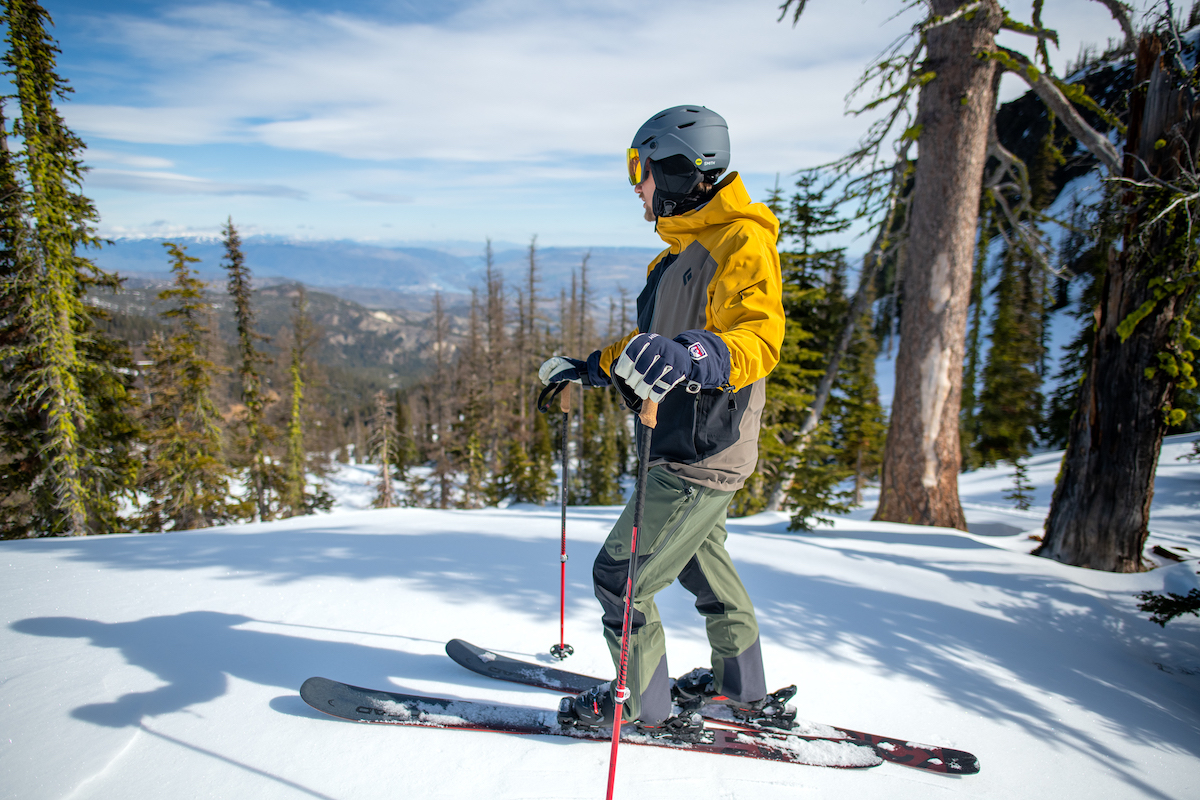
Unless you opt for a 3-in-1 jacket, you’ll likely want a dedicated midlayer for skiing. The amount of insulation can vary dramatically, from a thin fleece to a puffy down jacket. Fleece jackets are the classic choice for skiing, and can be quite warm and lightweight, but mid and heavyweight designs are bulky. Down is the pricey option but is unmatched in lightweight compressible warmth (just make sure to keep it dry because it will stop insulating when wet), and synthetic fill splits the difference. It has a fairly good warmth-to-weight ratio and retains its insulating properties when wet. For more on midlayers along with our top picks, see our article on the best midlayers.
.jpg)
Baselayers and their next-to-skin warmth are important in keeping you toasty and dry. A breathable and well-ventilated jacket will only perform as well as the baselayer underneath, so don’t skimp here. Synthetics, like those made by Patagonia or Helly Hansen, are comfortable and pull moisture away from your skin effectively at a reasonable cost. The downside is they are less soft and more prone to retaining unpleasant odors. Merino wool is expensive, but excels in temperature regulation and odor prevention. On all but the coldest days, our go-to baselayers are the lightweight or midweight options for a good balance of warmth and breathability.
Back to Our Top Ski Jacket Picks Back to Our Ski Jacket Comparison Table